Table of Contents
The evolution of a simple ear ring, mainly in women, has evolved into what we now know as ear piercing, taking advantage of all the areas that this part of the body has from the lobe to the cartilage, we can wear the one that we like the most.
This was possible mainly due to the exploration of fashion but also due to different types of materials that piercings began to make, which allowed us to use original designs on the pieces that were put on the ears.
To enjoy a new piercing that you are going to do soon and you are focused on your ears I will leave you in detail where you can do yourself and the type of ear piercing that suits you according to the chosen part.
It can be him lobe, tragus, antitragus, conch, snug, daith, rook, industrial, helix.
The earlobe is the part of the body where you feel the least pain when piercing yourself.
Consider that if you are a woman since childhood we already do perforations as soon as we are born and we are babies and that decision is made by our parents, now it is your turn to drill where you like.
Let’s start:
Types of Ear Piercing and their Names
Before getting a piercing, it is best to learn in what area of the body can be done and mainly what types of ear piercings can be performed as well as learn the names.
The clearer you have what you want and want, the easier it will be to explain to the professional what you want for your body.
You also have to consider that there are many parts of the ear as different types of piercings, so it is very useful to know them all to know what you will be exposed to later when applying the jewel and in its care.
Ear Lobe Piercing
This is the part that all girls when they are born are pierced to put on their hoops and generally differentiate that it is a girl.
It is located at the bottom of the ear and has a rounded shape.
I would risk saying that all women have that hole and they have it drilled.
It is the fleshy part of the ear lobe.
The features The main ones that piercing the ear lobe have are:
- You have pain under the piercing
- It is pierced through the rounded fleshy part of the ear.
- Its healing can take time from 1 to 2 months.
- It has a ring diameter of 0.8 millimeters with 20 grams to 2.5 millimeters with 10 grams of weight.
- The ring or jewel can be changed only 6 weeks after drilling.
- The jewel that is put on first is a BCR hoop type or it can be a barbell bar
Piercing the earlobe is the classic piercing that every woman does, but when the piercing model evolves, there are two leads that can be performed, which are those performed in the upper lobe and the transverse lobe.
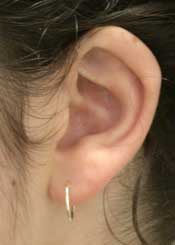
Transverse Lobe Piercing
It is drilled in the lower part of the lobe but it has the difference that has to be made perpendicular to the perforation that you can traditionally do.
So you will find that the hole is traversed from one side to the other taking the thickest part of your ear.
Due to the distance, you have to use a jewel in the style of a bar and that has equal terminations on both sides so that it causes a symmetrical style to the eye.
At first glance, it may seem painful, but as I said earlier, this area is very little painful, you will only feel a simple discomfort when doing it.
And the great benefit that it has is that it is full of flexible tissues so that when drilling is fast as its subsequent healing.
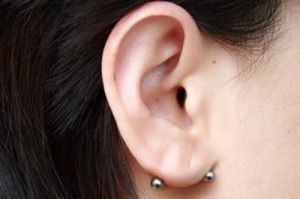
High Lobe Piercing
It has to be drilled in the upper part of the lobe taking as a reference where you have the hole of your birth rings.
This piercing is considered the first to be performed when you are interested in doing this type of practice, since it is the best option if you do not want to attract much attention but want to try something different within the aesthetics on your face.
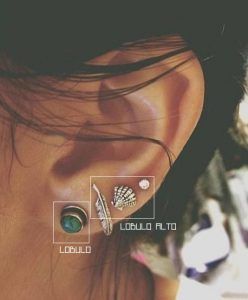
Lobe Dilations
If you want to use a large jewel that is striking you do not have to make a new piercing since using the hole in your rings that you have since you were born you can use an expander.
This is not a piercing but it is an applet to perform an expansion of your lobe in the ear step by step.
This is only done when the process of initially drilling you can already heal.
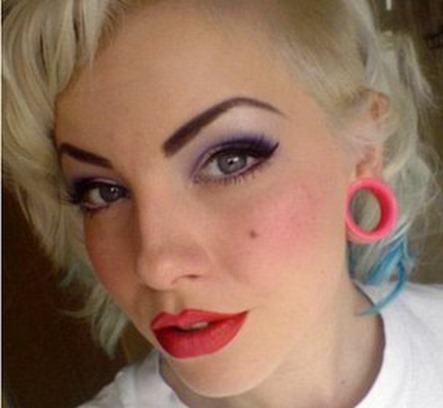
Tragus Piercing Cartilage
It is located right in the bump that has the cartilage that you can find in the lower area of the face.
It just matches the outside of your ears, to be more exact you can see over the central part of the ear canal of your ears.
The way in which it has to be pierced is horizontally, from the outside to the center of the ear.
This helps you know exactly where these types of ear piercings are done.
If I describe the different features that stand out the most can be named
- His pain is intense at the time it is performed and I can consider it as average pain for which you have to go to do it.
- The part that is pierced is through the tragus cartilage
- Given the area where it is drilled, you have to wait between 3 to 9 months depending on the person’s body for it to heal.
- The diameter of the jewels that go for this piercing must be 1 millimeter with a weight of 18 grams and 1.6 millimeters with 14 grams.
- It starts with a starting gem to start BCR, Mini Barbell, Straight Barbell or Labret.
- And after the drilling is done you have to wait for the jewel change only when the 2 months are up.
On this type of piercing there are two areas that can be applied, which are the antitragus piercing and the vertical tragus.
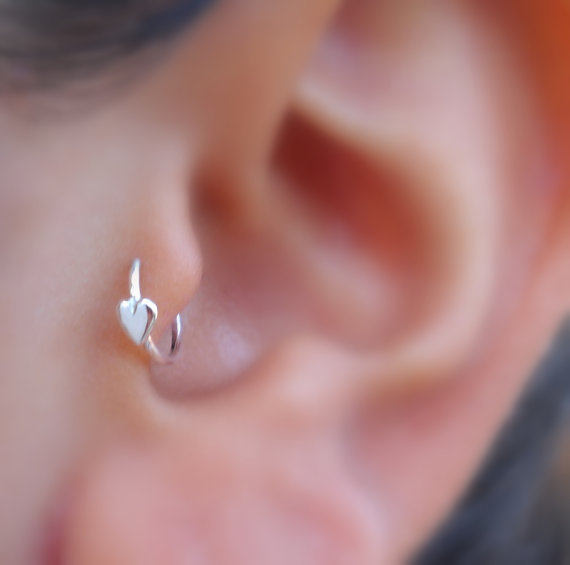
Antitragus Piercing
Its position where the piercing is performed is just on the opposite side of the ear from the tragus.
Without a doubt this is considered one of the piercing piercings that will hurt the most, so think twice and it takes a lot of value.
You have to think that their pain is considered one of the most painful at a medium and high level.
It may take 3 to 9 months for it to heal depending on how much care the wound takes.
It is pierced directly into the part of the small vertical ridge that has the cartilage located in the earlobe.
To make the first change of the initial jewel with which you started, it should be only 2 months old.
The diameter of any type of piercing you put in must be 1 millimeter with a weight of approximately 18 grams and 1.6 millimeters with 14 grams.
To do the piercing it is recommended to use a curved bar, the mini barbell or the BCR and also the Barbell.
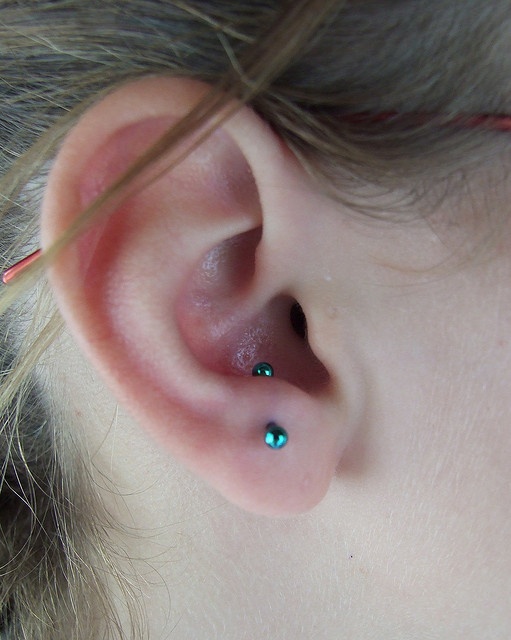
Tragus Vertical
This type of piercing has a problem that can be depending on how it is performed that can be torn, which is why many people do is choose to pierce the skin of the face where it is close to the drink itself.
This is because the vertical tragus piercing is done in the same part as the conventional one but unlike the position it is done vertically parallel to your face.
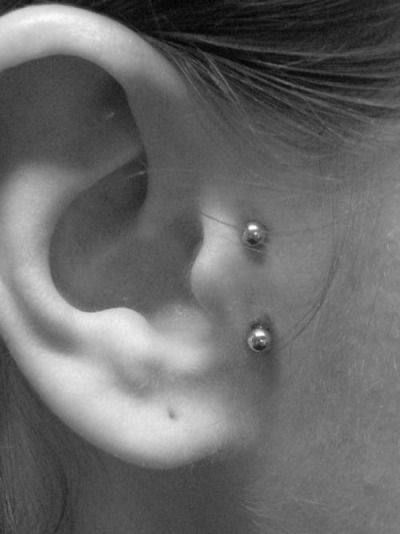
Piercing in the Helix (cartilage)
I risk saying that this area is one of the most popular since piercing fashion became almost viral and massive.
This type of position and jewel that is placed can be used all over the cartilage and that is what draws a lot of attention for taking everything around.
Spanning the top of the ear to the thickest cartilage tissue.
So that you know the main characteristics of the Helix it can tell you that it is painful because of the area it is in but it can be coped with.
You will feel an average pain and that you have to wait between 3 months of healing at least is what it usually takes although there are people with a slower healing that has taken up to 9 months to heal.
It pierces directly into the curved edge of the upper outer part of the ear of your choice.
The diameter of the jewel you wear must be 1 millimeter with a weight of 18 grams but it can reach a limit of 2.5 millimeters with 10 grams.
Only after 2 months you can change the first jewel you put on.
The type of jewel that you can put on to get the initial piercing can be a Nostril Screw, a mini Barbell, BCR or a Straight Barbell.
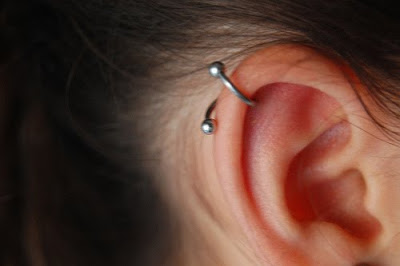
Piercing in the Antihelix (cartilage)
Unlike the previous one, what is done with this piercing is to place it right on the part of the curved edge that is between the ear and the head.
Its name is also called as forward helix and forward helix.
The pain of the piercing is intense, but I could say that you have to keep it in mind when doing this piercing that you can do it with a mini barbell or a straight barbell as well as with a BCR.
For the small part that is of the body it must be from a diameter of 1 mm to 1.6 mm no more than that and with a weight that does not exceed 18 to 14 grams.
The change is also made 2 months after the first jewel.
Healing has to wait from 4 months onwards, so very carefully the first year.
Consider that the cartilage is quite fine in this area, so you should consider this detail in what is the helix.
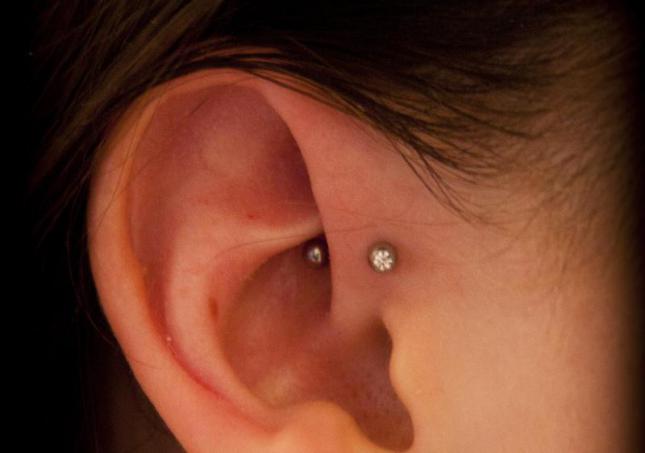
Rook Piercing (Tower)
This type of piercing I recommend that you do it with someone who really knows and has verifiable experience, for that you can ask them for a photo book of work done to demonstrate the precision it has.
I mention this because it is an area where the pain is quite intense when they pierce you and also because this part of the ear is very sensitive.
The healing will take you 6 months onwards, so you have to consider it because it is just the area where you lean the phone to speak or if you use headphones it can get complicated and lead you to become infected very often.
For that, use those months the hands-free on your phone and try not to listen to music with headphones so that the healing is as fast as possible.
The only jewelry you can wear to get your initial piercing are the curved bar and the BCR.
It is positioned on the small ridge of the cartilage at what is the top of your ear.
The jewel can be from 1 mm to 1.2 mm with a weight of 18g and 16g.
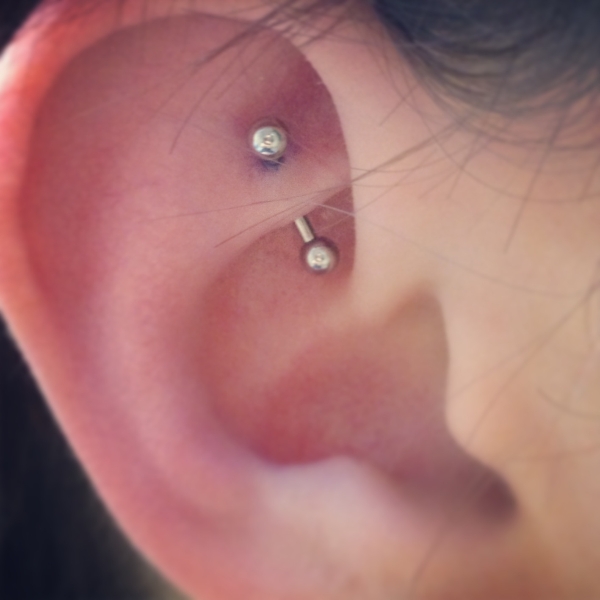
Daith Piercing
It is generally said that this piercing relieves you what migraines are if you suffer them and the temporary headache so it is good to take it into account.
This is because it is right in the ear position where it is a fundamental point to do acupuncture and eliminate the headache that affects millions of people.
Many people confuse this type of piercing with the tragus but it is not and it has a great advantage that it is very unlikely to have infections since it is located inside the ear.
It is quite painful when performed but then that pain passes instantly.
The healing takes between 3 and 5 months approximately and the initial jewel is changed after 2 months, although many people recommend that it be done after 3 months.
Another important point is the type of jewel that is used which is a curved bar and BCR at the beginning of the drilling.
You have to be 1 millimeter in diameter from the jewel to 1.6 millimeters with a weight of 14 to 18 grams.
Daith piercing is located on the inner ridge above the ear canal.
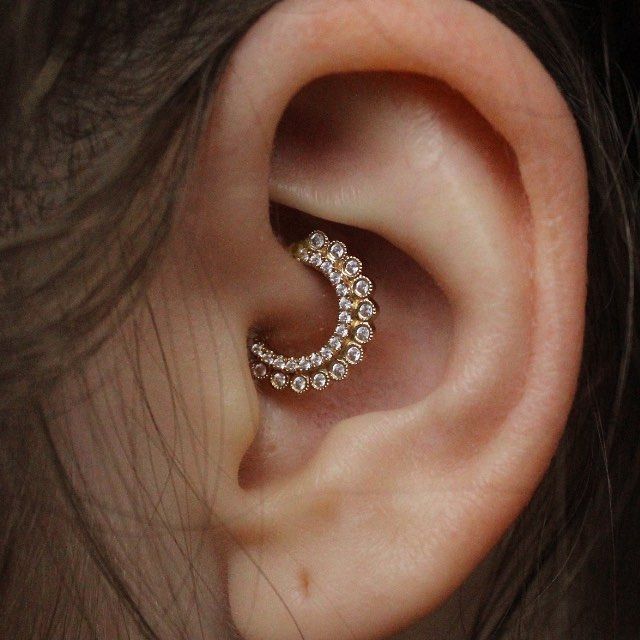
Industrial Piercing
It is also called cross piercing because of the location of the jewel.
This type of piercing is not recommended to be done by anyone, the best thing is first that a professional see the shape of your ear and that you be honest if it can be done or not.
This is because each ear is different and they have different tissues in what is quantity, so if they do not have the recommended characteristics and it is carried out equally it can generate constant tension in the ear causing pain and future health problems.
The idea is that when the piercing is made and the jewel is applied it is not taut since two piercings are made and it is joined by a straight bar.
That is why the starting gem used is the straight Barbell with a diameter of 1.6 millimeters that has 14 grams of weight.
The pain is very strong, that’s why you have to be very prepared and it will heal only after 3 to 6 months.
If you want to change the jewel you just wore, you can do it after 2 months after having a professional control to control the healing.
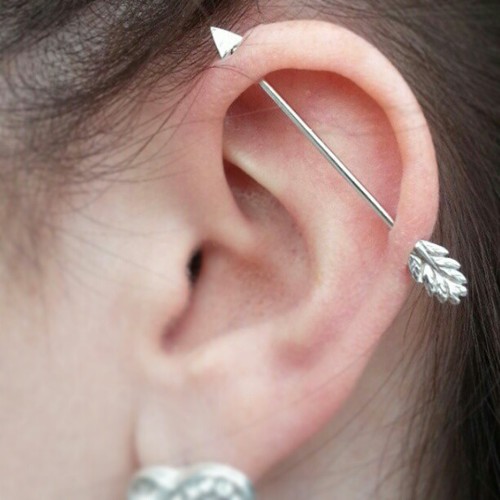
Industrial Vertical
This is a variation of industrial piercing where what changes is the position of the jewel but you have to have the same precautions when doing it.
As the name implies, what it does is to vertically join the two perforations that were made with the ear conch.
As you can also join the conch shell with the helix or the rook with the helix.
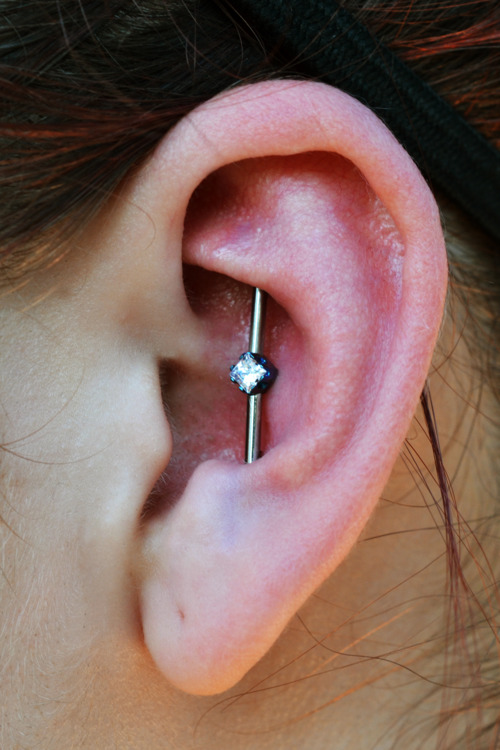
Conch Piercing
This is done mainly in the cartilage part of the ear in the central part.
Its original name is Conch Piercing but in its translation it is said as I mentioned above specifying that we are talking about the ear, as it is also known as conch piercing.
The pain is intense and it is in a medium but strong pain because it is right in the cartilage in the part of the middle that has a shape of an ear fossa.
The only jewel that you can put on is the barbell and the diameter is from 1.2mm to 2.5mm with a weight ranging from 16g to 10g
The healing is generally recommended for 6 months and it is only after 2 months that the jewel that started the piercing can be changed.
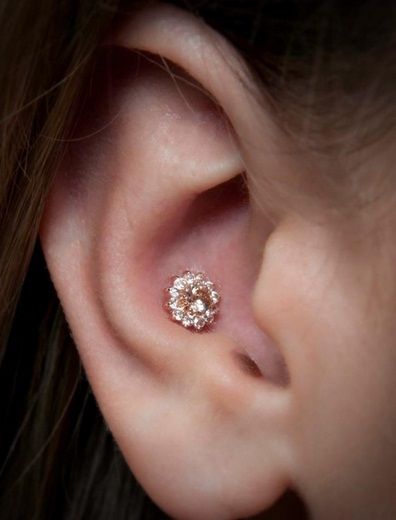
Inner conch shell
This is the variant that is most used and especially the one that everyone chooses to be more original in the ear.
This is done right in the bowl in the central part of the ear so it looks very nice but only an experienced professional can do it for you, since it is right near the ear hole.
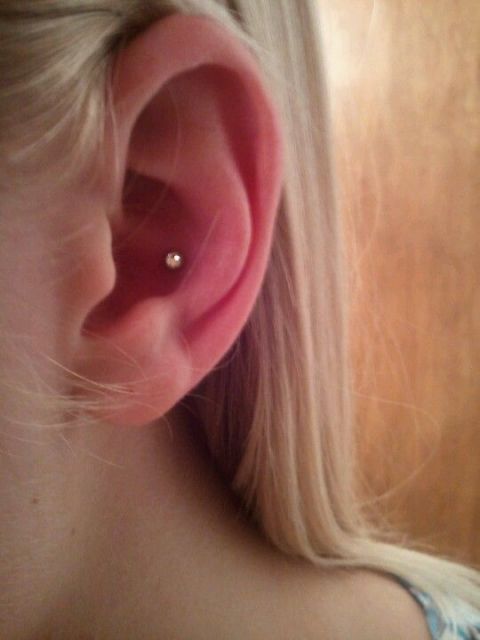
Exterior conch shell
It is very difficult to do compared to the previous one and it is also unusual for it to be done in a massive way but it is mainly perforated in the flat part of the cartilage.
Right on the upper outer part of the ear.
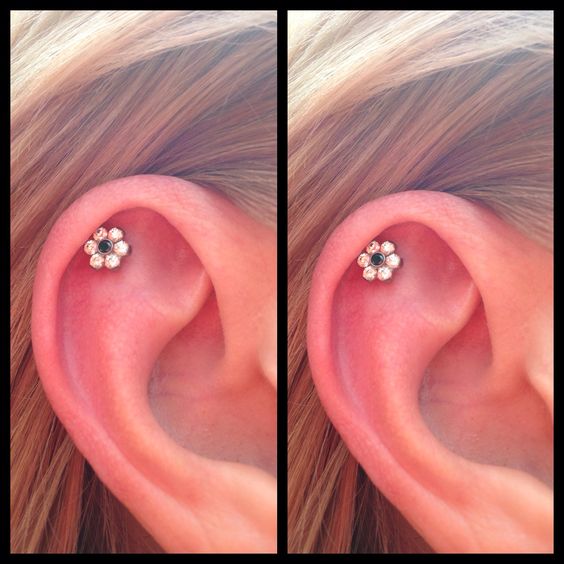
Orbital Piercing
This type of piercing is the most painful that I have named you so far, so imagine the pain exceeds the average of the others, so make yourself aware that it is so.
2 perforations have to be made and a medicinal ring is put in the hole.
When these piercings have just been healed, you can change the jewel for a single one that has to join what you pierced.
Therefore, what this method does and the steps that are carried out mainly avoid any type of complication that you have.
Many people have to wait 9 months for healing to be complete and complete.
The diameter of the jewelry used is 1.6 millimeters and weighs 14 grams.
As always, the change is made after two months but with great care.
And the curved barbell, the simple hoop or the hoop with the shape of a letter D is used to open this perforated area.
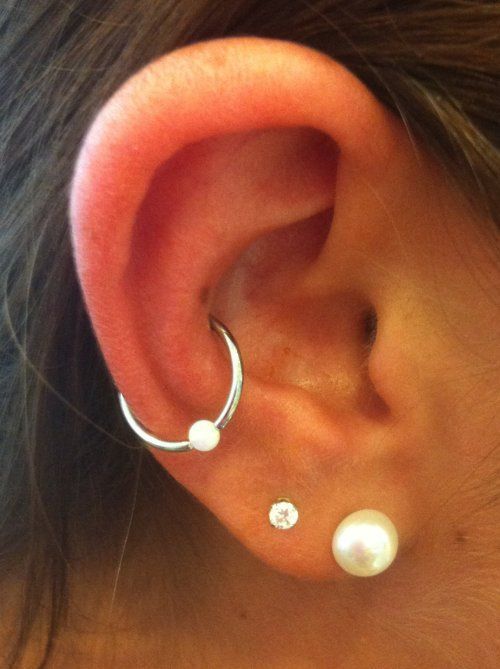
Snug Piercing
It is called this way because it refers to the part of the cartilage of the ear that has to go through said perforation when it is made.
It is very painful because of the location where it has to be drilled, but above all because it is located right in the part of the protuberance that is located vertically of the cartilage.
It takes 4 to 9 months to heal once done and the BCR or Barbell is used as a gem for the procedure.
The diameter of said jewel must be a minimum of 1 millimeter (18 grams) and a maximum of 1.6 millimeters (14 grams).
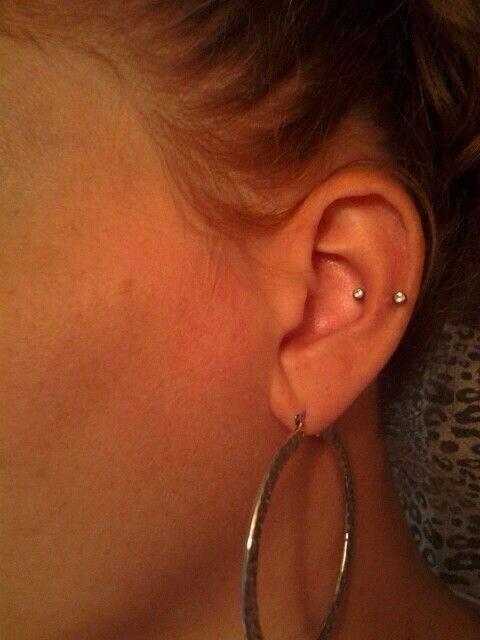
Ragnar Piercing
It specifically derives from the snug piercing but it differs that it comes out behind the ear when pierced.
But keep in mind that it does the same as the snug when drilling.
The scarring really is very complex and difficult needing the supervision of a doctor.
It is not recommended to do it because the area is very fragile but with a good expert everything is possible.
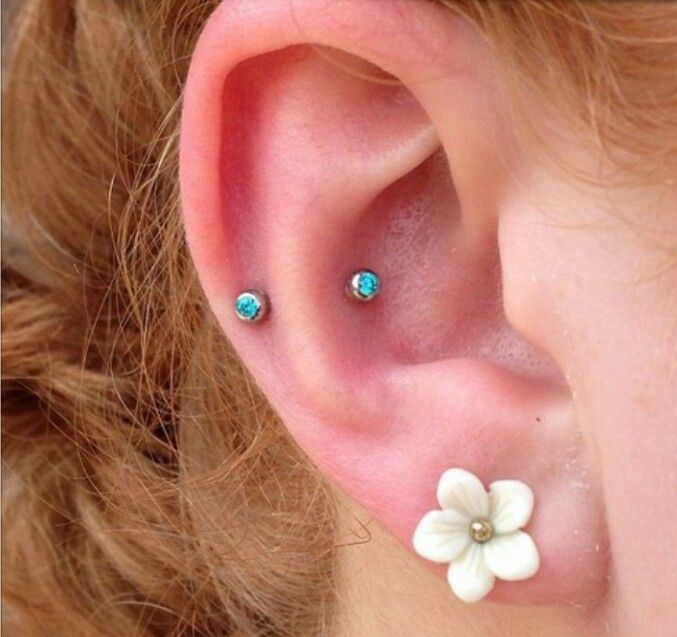
Ear piercing images
These are some photos that I got to show you about different types of piercings that you can do in your ear and have new ideas for you to compare how you can look.
Piercings in the shape of an arrow where you can see earrings in the entire cartilage area in the image
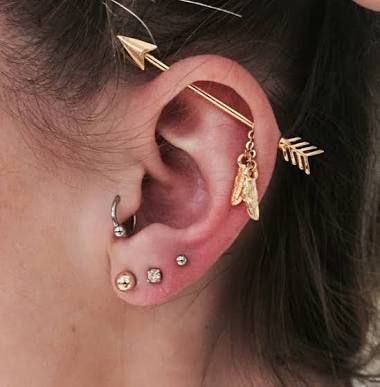
Very beautiful flower piercings in this detail that shows the image to share on facebook, pinterest and instagram
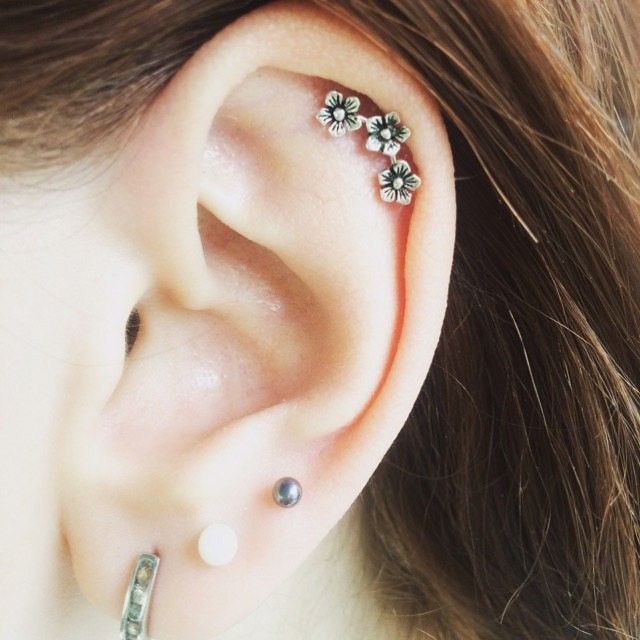
I really liked this shine that has the two piercings both on the bar and the internal one adding the image in the lobe of the shiny earring
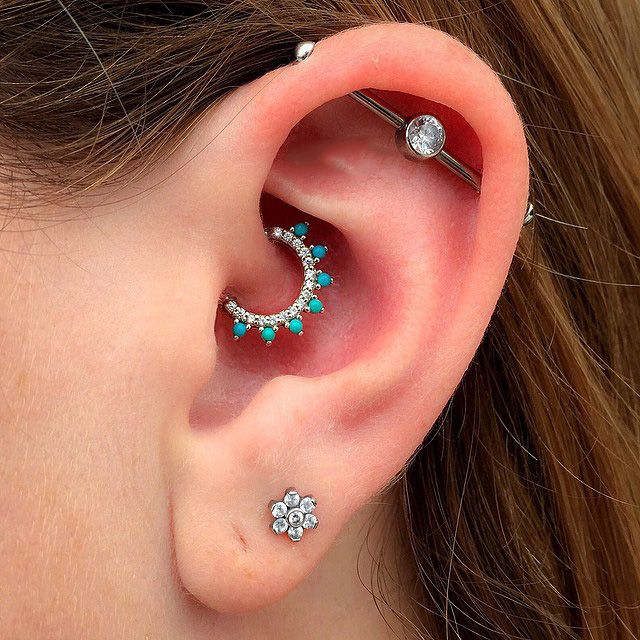
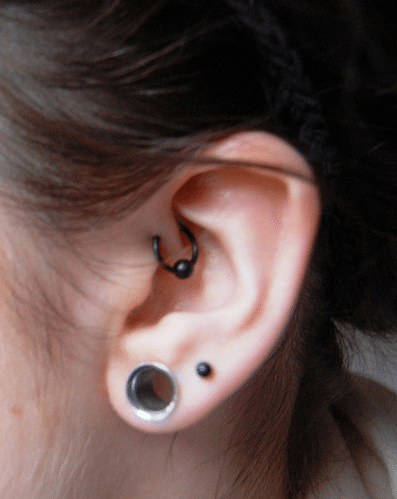
Image with many thematic earrings where piercings are protagonists throughout the ear
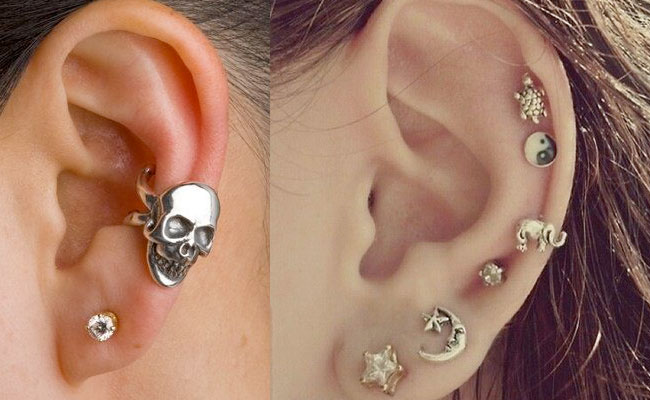
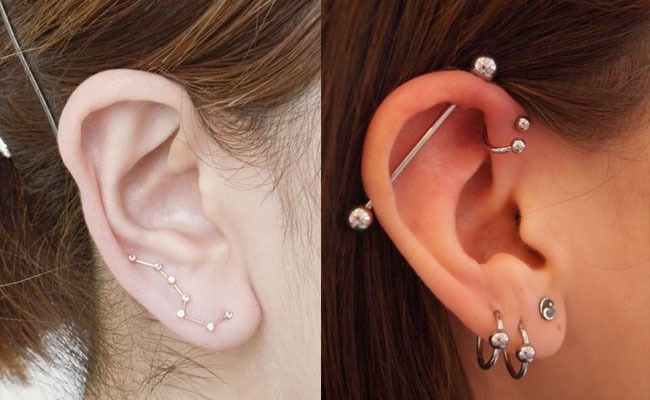
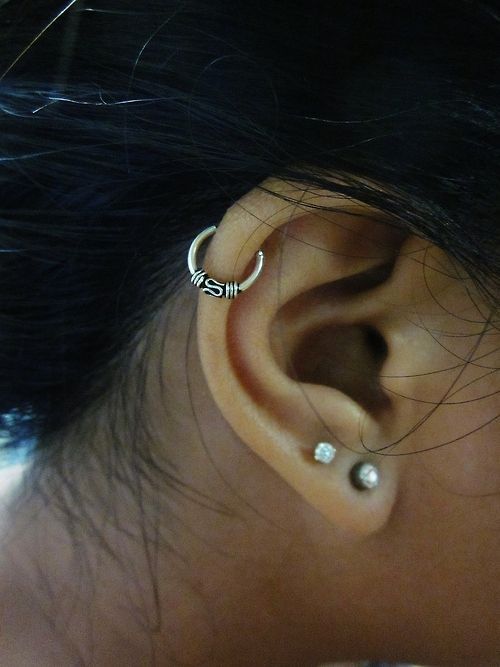
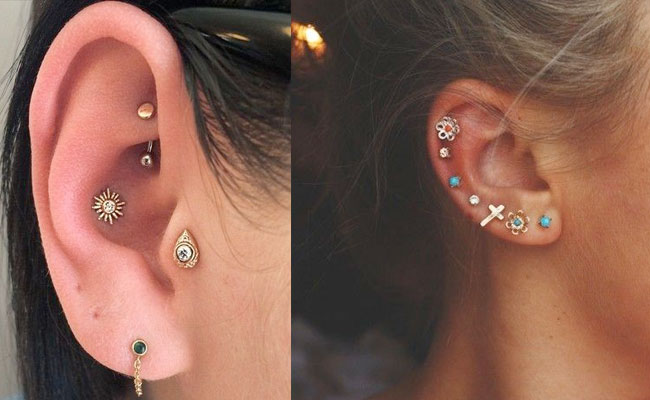
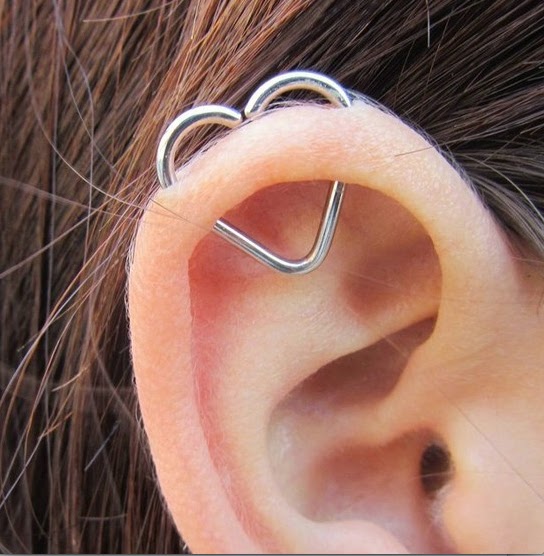
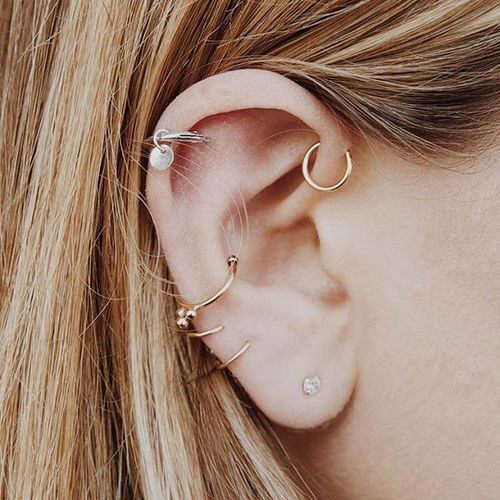
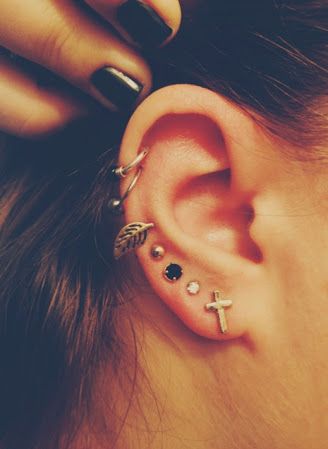
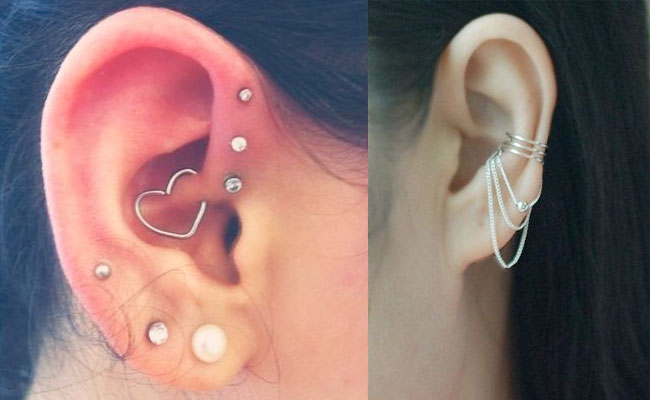
How to Pierce Your Ear: 7 Steps
Once you know what type of piercing you want to do and where you are going to put it on the part of the ear is to decide how you are going to do it.
Drilling is painful, that cannot be denied, but the pain tolerance of each individual is different.
The methodologies that exist to do an ear piercing are using an applicator gun to drill and with a special needle to make holes in the skin.
Catheter or Hollow Needle: This is the most common method used specifically by professionals who are dedicated to this. Generally, this type of piercer is also a tattoo artist, but not in all cases, but it is very common.
The benefit of this type of tools that the materials used to drill makes it a process that is as hygienic and healthy as possible.
There are different diameters to make the hole with this process
Diameter with Needle: 1.6 millimeters and 14 grams
Diameter with Catheter: 1.2 millimeters and 16 grams
Skin piercing gun: those who use this type of tool are nurses from hospitals or private clinics, as well as pharmacists who know how to pierce mainly the earlobe.
The mechanism that this type of tools has is using the same slope that is going to be left in the ear, which when activating the gun, what it does is drill the part of the ear where it is applied.
When this ring goes through the skin, it causes a tear in the tissues, so it is more likely that it will become infected and the healing process is longer compared to the needle.
So the one who investigates how to make the hole always chooses the first hollow needle method.
How to do an ear piercing?
These are the 7 steps that need to be implemented in order to perform the desired piercing on the chosen ear.
Pay attention and you will learn how to get an ear piercing
- The person who is going to make the hole should wash their hands very well with soap and water without fragrances, then put on new gloves that are disposable.
- An antiseptic such as ethyl alcohol, iodine or chlorhexidine must be applied to the area of the ear where it is going to be pierced.
- Mark the area through a point where you are going to drill, you can mark it by exerting a little pressure since with a marker or fiber what you do is infect the area again.
- Using a clamp to hold ears what you do is fix the part you want to create the hole so it is easy to maneuver easily.
- With the previous purchase of a catheter in a pharmacy or a hollow needle, you make the perforation at the marked point.
- Insert the earring or jewel that you want to use in the hole you just created making sure that the measurement of the needle is the same as that of the earring so that it fits perfectly into the hole, remember that it must be disinfected.
- You are going to withdraw the needle slowly and leave the earring in that place that will remain until it heals at least.
Does it hurt to get an ear piercing?
Tolerance to pain is different in each person, we already get it from a young age, so piercing will not be the same for you as it is for a friend.
For this reason, never be guided by what others tell you, but by what is known for sure as the intensity of pain.
To give you an idea, the piercing that generates the most pain in the ear is the one that is made right in the cartilage of the ear and the one that generates the least pain is the lobe, this has a reason and that is that if you look you have greater sensitivity in cartilage than in the lobe.
When you make a piercing in the earlobe, there really is so little pain that you feel that it is only a discomfort when it is performed, but after the fortunate piercing that you wanted so much is done, when that discomfort that happens to all of us appears.
To give you an idea of the intensity of pain in the earlobe, if you do it with the gun it is much more painful than if you do it with a hollow needle.
On the other hand, if you are going to pierce yourself in some part of the cartilage of one of your ears, it is much more painful and, as I mentioned before, the pain appears after you did the piercing, especially the first weeks where the wound healing begins to take place. .
How to reduce the pain of piercing?
These tips I recommend that you keep in mind so as not to suffer pain when doing this type of ear piercing practice.
Before drilling you have to apply ice to the cold because what you do is numb the area and feel much less pain.
You can do this with an ice pack or there are also spray bottles to apply in the right area, cold packed. You can buy it in a sports store or a pharmacy, athletes apply it a lot.
Another fundamental point is the attitude you have, if you are afraid to get the piercing it will surely hurt much more so you have to go with the best winning and positive attitude, relaxed and thinking that if you do it, it is because you like it .
Take a lot of air just at the moment you make the applet to drill.
Then you have another stage which is “the after” of the piercing.
To avoid pain you should make these recommendations:
- At the moment of piercing your ear you have to take an over-the-counter pain reliever that is sold in any pharmacy so that your pain is mainly alleviated the first week
- Do not exert any type of pressure in the area where you pierced yourself, when you have to sleep, sleep on the opposite side to the pierced ear or face up.
- If it does not heal and does not heal, avoid using headphones, ear muffs for the cold or some kind of bathing cap since that does not favor scarring or pain.
- I understand that you want to touch your ear to see how the earring fits you but try not to, just touch your ear to perform the healing without moving the jewel you put on so that it heals faster.
- Do not use alcohol it will hurt a lot if you do it, do not apply hydrogen peroxide or any type of iodine solution. Just use unscented white soap and plenty of tap water which will avoid drying out the area.
- You have to have a behavior and routine to be able to sanitize the area with the recommendations that the professional who made the hole in your ear gives you to properly maintain the healing.
How to care for an ear piercing
The main problem you have after piercing an ear is poor hygiene and healing of the area.
In a sense, much more goes through the attention and personality as dedication than the individual gives it than a poorly performed piercing.
To avoid complications, you have to take the most detailed care possible and take it as a responsibility within your hygiene routine.
- Changing the jewel that you have in your ear is the first mistake that is made, so you always have to wait the time they recommend, exceeding 3 months, How long does it take to heal an ear piercing? more specifically if you want to know it is 2 months for the perforation in the cartilage and 1 month onwards as regards part of the lobe.
- If you like to put on makeup or use perfume it is very good that you do it but please avoid touching the piercing or it will irritate you.
- After you do sports or if you practice swimming, avoid washing your ears after practicing the activity so that you do not become infected mainly with perspiration.
- Having a swab soaked in a saline solution or a saline solution can be an excellent idea for after you wash.
- So that the area is not wet you have to dry it with a tissue or it can be a wipe that is discarded. Do not do it with the towels to dry your body because you can add fungus to your healing.
- Neutral soap is always the best for this type of practice and that is why you have to wash with plenty of water if possible that is not too cold, better warm and do this practice at least 2 times in your day.
- You should always wash your hands with soap and water before touching the piercing.
These details that out there you may think are logical I can assure you that the greatest consultation that is made by infections is due to the fact that they do not perform this type of procedure.
Risks of Piercing your ear
Like any intervention with the human body, there are some risks, although they are minimal for ear piercings, but you must try to avoid them while maintaining the aforementioned recommendations.
From infections to tears as well as scars called keloids that are generated according to the perforation or allergies depending on the material used in the jewel.
Ripped: This happens when the hole made is stretched and can even lead to a break in the entire hole, for which care is extreme.
For this reason you have to take into account that you do not get hooked and stick inadvertently as well as the weight of your hoop or earring since if it has a lot of weight it weakens the area.
Allergies: it is very common to have allergic reactions to the metal of the jewel that you use, so it is always recommended to use surgical steel material or if you are given a budget, those that are made with titanium raw materials.
An infection is often confused when you have an allergy which has nothing to do with it and it is important the differences mainly that it gives you a feeling at first that it burns and that if you have a wound it begins to expand without the ear swelling .
InfectionsOn the other hand, an infection that is very common to happen inside the piercing of the piercing when it has been done for a few hours or days.
If you notice that it turns red or red where you pierced yourself, you have a lot of pain, it begins to swell and you notice that it secretes a type of liquid which has a yellow and white color.
Keloid scars: This happens when it begins to form as if it were an overreaction for what you did to yourself and exceeds the diameter of what you pierced yourself.
It also makes you itchy.
Without a doubt the solution is to go to your dermatologist to see what steps to follow.
How to disinfect an ear piercing
- The first step you have to do is consult the same professional who makes the piercing hole, which is the correct way to disinfect it.
- Within the precautions, do not apply moisturizers or makeup as I mentioned above
- If your problem is that you have an infected piercing, then you have to clean and heal the hole you made by washing the area with neutral soap and plenty of water, but avoid using iodine and chlorhexidine.
- Add physiological serum through a spray bottle or it can also be sea water
- Apply over-the-counter anti-inflammatory ointment
If you were able to cure the infection that appeared to you, then you should avoid re-infection, which is why you take good care of that part of the body that you pierced.
Types of earrings in the ear
When it is your first time that you are going to do a piercing it is recommended to use the best materials.
When you are a newborn and your parents decide to wear earrings they try to buy the one that is the best quality and is within their means.
I was lucky to be able to buy my daughters white gold it was very expensive but a beautiful memory that I will always have to show them when they are older.
But if the idea is to get a bigger ear piercing, what you have to choose are materials that are metal, since there are plastic and glass in any jewelry that sells piercing elements.
It does not mean that one is better than another but the quality and the different allergic reactions that it can produce to the skin of each woman.
The biocompatibility that you have with the chosen material is essential, so you have to know which one is the most tolerated by your body to avoid scarring being a problem or generating an ear infection or allergic reaction.
Another point is that it has to be resistant to corrosion so there are many details to take into account to avoid problems.
Something very interesting about the earlobe piercings is that you have a number of incredible designs to choose from what you can think of and the theme that you like the most.
But always respecting the shape of a hoop or bar shape earring as the piercing corresponds.
I always recommend that you choose those that are nickel free regarding the material, you have to look and ask.
I advise you since the metal that most generates allergies is undoubtedly nickel and this can produce you when it is in contact with your skin, which is what happens to me and I try to avoid it at all costs.
But What types of materials to use for the ear?
My first option is titanium since it is undoubtedly the best that accepts the human body.
Then I lean towards him gold both white gold and golden yellow gold, as long as this type of precious metal is real and from 14 carats.
Also the option of surgical steel without a doubt it is a very advisable option since imagine that it is used for the first earring that you usually wear. Tip that it is type 316 LVM this will give it higher quality and authenticity.
The silver es muy popular y me arriesgo a decir que es el que mas se vende por su precio pero no te lo recomiendo por que tiene en algunas aleaciones que nunca te vas a enterar el níquel.
Por supuesto que si te decides por este material por lo menos utilizarlo cuando el agujero ya este cicatrizado y si solo es para la zona del lóbulo ya que en otro lado afectaría.
Si nada de esto te convence siempre tienes la opción que yo recomiendo antes de hacerte un piercing para ver como te queda y te compras un piercing falso para la oreja.
Luego de unas semanas si notas que te gusta como te queda y es lo que buscabas te lo puedes hacer definitivo.
Cuanto cuestan los piercing en la oreja
El precio puede variar dependiendo donde te lo hagas y con quien te hagas el piercing en la oreja por eso siempre recomiendo hacerlo con personas que sean profesionales y que tengan un book o carpeta comprobable con sus trabajos
Cuando digo un profesional que sea cualificado me refiero que tenga su estudio de tatuaje y piercing, sus herramientas profesionales y sobre todo que este habilitado demostrando su higiene que lo que hace utilizando productos desechables si fuera necesario.
Para que tengas una idea y guía el perforarte el lóbulo de la oreja como el cartílago te pueden llegar a cobrar uno 13 dolares aproximadamente incluyendo el Tragus, Antitragus o bien el Daith or Rook.
En cambio cuando tienes que hacer un Industrial o un Orbital que son más complicados lleva un costo de unos 25 dolares aproximadamente por su complejidad y por que son dos agujeros.
Luego el tipo de joya que utilices eso varia su precio pero son muy fáciles de acceder ya que su precio no es muy costoso siempre y cuando utilices las piezas clásicas.
Las joyas falsas puedes conseguirlas por 3 dolares.
Recuerda que te lo planteo en dolares para que tu puedas adaptar el precio a la moneda de tu país, también me gustaría leer en los comentarios los precios que ustedes conocen y mencionen el país o zona que se encuentran seguramente le servirá a otras personas que lean esta guía.
Video de Tipos de Piercing en la Oreja
Queridos amigos los despido hasta el próximo informe y los invito a compartir en las redes sociales para ayudar a una amiga que quiera hacerte un piercing en la oreja.
The evolution of a simple ear ring, mainly in women, has evolved into what we now know as ear piercing, taking advantage of all the areas that this part of the body has from the lobe to the cartilage, we can wear the one that we like the most.
This was possible mainly due to the exploration of fashion but also due to different types of materials that piercings began to make, which allowed us to use original designs on the pieces that were put on the ears.
To enjoy a new piercing that you are going to do soon and you are focused on your ears I will leave you in detail where you can do yourself and the type of ear piercing that suits you according to the chosen part.
It can be him lobe, tragus, antitragus, conch, snug, daith, rook, industrial, helix.
The earlobe is the part of the body where you feel the least pain when piercing yourself.
Consider that if you are a woman since childhood we already do perforations as soon as we are born and we are babies and that decision is made by our parents, now it is your turn to drill where you like.
Let’s start:
Types of Ear Piercing and their Names
Before getting a piercing, it is best to learn in what area of the body can be done and mainly what types of ear piercings can be performed as well as learn the names.
The clearer you have what you want and want, the easier it will be to explain to the professional what you want for your body.
You also have to consider that there are many parts of the ear as different types of piercings, so it is very useful to know them all to know what you will be exposed to later when applying the jewel and in its care.
Ear Lobe Piercing
This is the part that all girls when they are born are pierced to put on their hoops and generally differentiate that it is a girl.
It is located at the bottom of the ear and has a rounded shape.
I would risk saying that all women have that hole and they have it drilled.
It is the fleshy part of the ear lobe.
The features The main ones that piercing the ear lobe have are:
- You have pain under the piercing
- It is pierced through the rounded fleshy part of the ear.
- Its healing can take time from 1 to 2 months.
- It has a ring diameter of 0.8 millimeters with 20 grams to 2.5 millimeters with 10 grams of weight.
- The ring or jewel can be changed only 6 weeks after drilling.
- The jewel that is put on first is a BCR hoop type or it can be a barbell bar
Piercing the earlobe is the classic piercing that every woman does, but when the piercing model evolves, there are two leads that can be performed, which are those performed in the upper lobe and the transverse lobe.

Transverse Lobe Piercing
It is drilled in the lower part of the lobe but it has the difference that has to be made perpendicular to the perforation that you can traditionally do.
So you will find that the hole is traversed from one side to the other taking the thickest part of your ear.
Due to the distance, you have to use a jewel in the style of a bar and that has equal terminations on both sides so that it causes a symmetrical style to the eye.
At first glance, it may seem painful, but as I said earlier, this area is very little painful, you will only feel a simple discomfort when doing it.
And the great benefit that it has is that it is full of flexible tissues so that when drilling is fast as its subsequent healing.

High Lobe Piercing
It has to be drilled in the upper part of the lobe taking as a reference where you have the hole of your birth rings.
This piercing is considered the first to be performed when you are interested in doing this type of practice, since it is the best option if you do not want to attract much attention but want to try something different within the aesthetics on your face.

Lobe Dilations
If you want to use a large jewel that is striking you do not have to make a new piercing since using the hole in your rings that you have since you were born you can use an expander.
This is not a piercing but it is an applet to perform an expansion of your lobe in the ear step by step.
This is only done when the process of initially drilling you can already heal.

Tragus Piercing Cartilage
It is located right in the bump that has the cartilage that you can find in the lower area of the face.
It just matches the outside of your ears, to be more exact you can see over the central part of the ear canal of your ears.
The way in which it has to be pierced is horizontally, from the outside to the center of the ear.
This helps you know exactly where these types of ear piercings are done.
If I describe the different features that stand out the most can be named
- His pain is intense at the time it is performed and I can consider it as average pain for which you have to go to do it.
- The part that is pierced is through the tragus cartilage
- Given the area where it is drilled, you have to wait between 3 to 9 months depending on the person’s body for it to heal.
- The diameter of the jewels that go for this piercing must be 1 millimeter with a weight of 18 grams and 1.6 millimeters with 14 grams.
- It starts with a starting gem to start BCR, Mini Barbell, Straight Barbell or Labret.
- And after the drilling is done you have to wait for the jewel change only when the 2 months are up.
On this type of piercing there are two areas that can be applied, which are the antitragus piercing and the vertical tragus.

Antitragus Piercing
Its position where the piercing is performed is just on the opposite side of the ear from the tragus.
Without a doubt this is considered one of the piercing piercings that will hurt the most, so think twice and it takes a lot of value.
You have to think that their pain is considered one of the most painful at a medium and high level.
It may take 3 to 9 months for it to heal depending on how much care the wound takes.
It is pierced directly into the part of the small vertical ridge that has the cartilage located in the earlobe.
To make the first change of the initial jewel with which you started, it should be only 2 months old.
The diameter of any type of piercing you put in must be 1 millimeter with a weight of approximately 18 grams and 1.6 millimeters with 14 grams.
To do the piercing it is recommended to use a curved bar, the mini barbell or the BCR and also the Barbell.

Tragus Vertical
This type of piercing has a problem that can be depending on how it is performed that can be torn, which is why many people do is choose to pierce the skin of the face where it is close to the drink itself.
This is because the vertical tragus piercing is done in the same part as the conventional one but unlike the position it is done vertically parallel to your face.

Piercing in the Helix (cartilage)
I risk saying that this area is one of the most popular since piercing fashion became almost viral and massive.
This type of position and jewel that is placed can be used all over the cartilage and that is what draws a lot of attention for taking everything around.
Spanning the top of the ear to the thickest cartilage tissue.
So that you know the main characteristics of the Helix it can tell you that it is painful because of the area it is in but it can be coped with.
You will feel an average pain and that you have to wait between 3 months of healing at least is what it usually takes although there are people with a slower healing that has taken up to 9 months to heal.
It pierces directly into the curved edge of the upper outer part of the ear of your choice.
The diameter of the jewel you wear must be 1 millimeter with a weight of 18 grams but it can reach a limit of 2.5 millimeters with 10 grams.
Only after 2 months you can change the first jewel you put on.
The type of jewel that you can put on to get the initial piercing can be a Nostril Screw, a mini Barbell, BCR or a Straight Barbell.

Piercing in the Antihelix (cartilage)
Unlike the previous one, what is done with this piercing is to place it right on the part of the curved edge that is between the ear and the head.
Its name is also called as forward helix and forward helix.
The pain of the piercing is intense, but I could say that you have to keep it in mind when doing this piercing that you can do it with a mini barbell or a straight barbell as well as with a BCR.
For the small part that is of the body it must be from a diameter of 1 mm to 1.6 mm no more than that and with a weight that does not exceed 18 to 14 grams.
The change is also made 2 months after the first jewel.
Healing has to wait from 4 months onwards, so very carefully the first year.
Consider that the cartilage is quite fine in this area, so you should consider this detail in what is the helix.

Rook Piercing (Tower)
This type of piercing I recommend that you do it with someone who really knows and has verifiable experience, for that you can ask them for a photo book of work done to demonstrate the precision it has.
I mention this because it is an area where the pain is quite intense when they pierce you and also because this part of the ear is very sensitive.
The healing will take you 6 months onwards, so you have to consider it because it is just the area where you lean the phone to speak or if you use headphones it can get complicated and lead you to become infected very often.
For that, use those months the hands-free on your phone and try not to listen to music with headphones so that the healing is as fast as possible.
The only jewelry you can wear to get your initial piercing are the curved bar and the BCR.
It is positioned on the small ridge of the cartilage at what is the top of your ear.
The jewel can be from 1 mm to 1.2 mm with a weight of 18g and 16g.

Daith Piercing
It is generally said that this piercing relieves you what migraines are if you suffer them and the temporary headache so it is good to take it into account.
This is because it is right in the ear position where it is a fundamental point to do acupuncture and eliminate the headache that affects millions of people.
Many people confuse this type of piercing with the tragus but it is not and it has a great advantage that it is very unlikely to have infections since it is located inside the ear.
It is quite painful when performed but then that pain passes instantly.
The healing takes between 3 and 5 months approximately and the initial jewel is changed after 2 months, although many people recommend that it be done after 3 months.
Another important point is the type of jewel that is used which is a curved bar and BCR at the beginning of the drilling.
You have to be 1 millimeter in diameter from the jewel to 1.6 millimeters with a weight of 14 to 18 grams.
Daith piercing is located on the inner ridge above the ear canal.

Industrial Piercing
It is also called cross piercing because of the location of the jewel.
This type of piercing is not recommended to be done by anyone, the best thing is first that a professional see the shape of your ear and that you be honest if it can be done or not.
This is because each ear is different and they have different tissues in what is quantity, so if they do not have the recommended characteristics and it is carried out equally it can generate constant tension in the ear causing pain and future health problems.
The idea is that when the piercing is made and the jewel is applied it is not taut since two piercings are made and it is joined by a straight bar.
That is why the starting gem used is the straight Barbell with a diameter of 1.6 millimeters that has 14 grams of weight.
The pain is very strong, that’s why you have to be very prepared and it will heal only after 3 to 6 months.
If you want to change the jewel you just wore, you can do it after 2 months after having a professional control to control the healing.

Industrial Vertical
This is a variation of industrial piercing where what changes is the position of the jewel but you have to have the same precautions when doing it.
As the name implies, what it does is to vertically join the two perforations that were made with the ear conch.
As you can also join the conch shell with the helix or the rook with the helix.

Conch Piercing
This is done mainly in the cartilage part of the ear in the central part.
Its original name is Conch Piercing but in its translation it is said as I mentioned above specifying that we are talking about the ear, as it is also known as conch piercing.
The pain is intense and it is in a medium but strong pain because it is right in the cartilage in the part of the middle that has a shape of an ear fossa.
The only jewel that you can put on is the barbell and the diameter is from 1.2mm to 2.5mm with a weight ranging from 16g to 10g
The healing is generally recommended for 6 months and it is only after 2 months that the jewel that started the piercing can be changed.

Inner conch shell
This is the variant that is most used and especially the one that everyone chooses to be more original in the ear.
This is done right in the bowl in the central part of the ear so it looks very nice but only an experienced professional can do it for you, since it is right near the ear hole.

Exterior conch shell
It is very difficult to do compared to the previous one and it is also unusual for it to be done in a massive way but it is mainly perforated in the flat part of the cartilage.
Right on the upper outer part of the ear.

Orbital Piercing
This type of piercing is the most painful that I have named you so far, so imagine the pain exceeds the average of the others, so make yourself aware that it is so.
2 perforations have to be made and a medicinal ring is put in the hole.
When these piercings have just been healed, you can change the jewel for a single one that has to join what you pierced.
Therefore, what this method does and the steps that are carried out mainly avoid any type of complication that you have.
Many people have to wait 9 months for healing to be complete and complete.
The diameter of the jewelry used is 1.6 millimeters and weighs 14 grams.
As always, the change is made after two months but with great care.
And the curved barbell, the simple hoop or the hoop with the shape of a letter D is used to open this perforated area.

Snug Piercing
It is called this way because it refers to the part of the cartilage of the ear that has to go through said perforation when it is made.
It is very painful because of the location where it has to be drilled, but above all because it is located right in the part of the protuberance that is located vertically of the cartilage.
It takes 4 to 9 months to heal once done and the BCR or Barbell is used as a gem for the procedure.
The diameter of said jewel must be a minimum of 1 millimeter (18 grams) and a maximum of 1.6 millimeters (14 grams).

Ragnar Piercing
It specifically derives from the snug piercing but it differs that it comes out behind the ear when pierced.
But keep in mind that it does the same as the snug when drilling.
The scarring really is very complex and difficult needing the supervision of a doctor.
It is not recommended to do it because the area is very fragile but with a good expert everything is possible.

Ear piercing images
These are some photos that I got to show you about different types of piercings that you can do in your ear and have new ideas for you to compare how you can look.
Piercings in the shape of an arrow where you can see earrings in the entire cartilage area in the image

Very beautiful flower piercings in this detail that shows the image to share on facebook, pinterest and instagram

I really liked this shine that has the two piercings both on the bar and the internal one adding the image in the lobe of the shiny earring


Image with many thematic earrings where piercings are protagonists throughout the ear








How to Pierce Your Ear: 7 Steps
Once you know what type of piercing you want to do and where you are going to put it on the part of the ear is to decide how you are going to do it.
Drilling is painful, that cannot be denied, but the pain tolerance of each individual is different.
The methodologies that exist to do an ear piercing are using an applicator gun to drill and with a special needle to make holes in the skin.
Catheter or Hollow Needle: This is the most common method used specifically by professionals who are dedicated to this. Generally, this type of piercer is also a tattoo artist, but not in all cases, but it is very common.
The benefit of this type of tools that the materials used to drill makes it a process that is as hygienic and healthy as possible.
There are different diameters to make the hole with this process
Diameter with Needle: 1.6 millimeters and 14 grams
Diameter with Catheter: 1.2 millimeters and 16 grams
Skin piercing gun: those who use this type of tool are nurses from hospitals or private clinics, as well as pharmacists who know how to pierce mainly the earlobe.
The mechanism that this type of tools has is using the same slope that is going to be left in the ear, which when activating the gun, what it does is drill the part of the ear where it is applied.
When this ring goes through the skin, it causes a tear in the tissues, so it is more likely that it will become infected and the healing process is longer compared to the needle.
So the one who investigates how to make the hole always chooses the first hollow needle method.
How to do an ear piercing?
These are the 7 steps that need to be implemented in order to perform the desired piercing on the chosen ear.
Pay attention and you will learn how to get an ear piercing
- The person who is going to make the hole should wash their hands very well with soap and water without fragrances, then put on new gloves that are disposable.
- An antiseptic such as ethyl alcohol, iodine or chlorhexidine must be applied to the area of the ear where it is going to be pierced.
- Mark the area through a point where you are going to drill, you can mark it by exerting a little pressure since with a marker or fiber what you do is infect the area again.
- Using a clamp to hold ears what you do is fix the part you want to create the hole so it is easy to maneuver easily.
- With the previous purchase of a catheter in a pharmacy or a hollow needle, you make the perforation at the marked point.
- Insert the earring or jewel that you want to use in the hole you just created making sure that the measurement of the needle is the same as that of the earring so that it fits perfectly into the hole, remember that it must be disinfected.
- You are going to withdraw the needle slowly and leave the earring in that place that will remain until it heals at least.
Does it hurt to get an ear piercing?
Tolerance to pain is different in each person, we already get it from a young age, so piercing will not be the same for you as it is for a friend.
For this reason, never be guided by what others tell you, but by what is known for sure as the intensity of pain.
To give you an idea, the piercing that generates the most pain in the ear is the one that is made right in the cartilage of the ear and the one that generates the least pain is the lobe, this has a reason and that is that if you look you have greater sensitivity in cartilage than in the lobe.
When you make a piercing in the earlobe, there really is so little pain that you feel that it is only a discomfort when it is performed, but after the fortunate piercing that you wanted so much is done, when that discomfort that happens to all of us appears.
To give you an idea of the intensity of pain in the earlobe, if you do it with the gun it is much more painful than if you do it with a hollow needle.
On the other hand, if you are going to pierce yourself in some part of the cartilage of one of your ears, it is much more painful and, as I mentioned before, the pain appears after you did the piercing, especially the first weeks where the wound healing begins to take place. .
How to reduce the pain of piercing?
These tips I recommend that you keep in mind so as not to suffer pain when doing this type of ear piercing practice.
Before drilling you have to apply ice to the cold because what you do is numb the area and feel much less pain.
You can do this with an ice pack or there are also spray bottles to apply in the right area, cold packed. You can buy it in a sports store or a pharmacy, athletes apply it a lot.
Another fundamental point is the attitude you have, if you are afraid to get the piercing it will surely hurt much more so you have to go with the best winning and positive attitude, relaxed and thinking that if you do it, it is because you like it .
Take a lot of air just at the moment you make the applet to drill.
Then you have another stage which is “the after” of the piercing.
To avoid pain you should make these recommendations:
- At the moment of piercing your ear you have to take an over-the-counter pain reliever that is sold in any pharmacy so that your pain is mainly alleviated the first week
- Do not exert any type of pressure in the area where you pierced yourself, when you have to sleep, sleep on the opposite side to the pierced ear or face up.
- If it does not heal and does not heal, avoid using headphones, ear muffs for the cold or some kind of bathing cap since that does not favor scarring or pain.
- I understand that you want to touch your ear to see how the earring fits you but try not to, just touch your ear to perform the healing without moving the jewel you put on so that it heals faster.
- Do not use alcohol it will hurt a lot if you do it, do not apply hydrogen peroxide or any type of iodine solution. Just use unscented white soap and plenty of tap water which will avoid drying out the area.
- You have to have a behavior and routine to be able to sanitize the area with the recommendations that the professional who made the hole in your ear gives you to properly maintain the healing.
How to care for an ear piercing
The main problem you have after piercing an ear is poor hygiene and healing of the area.
In a sense, much more goes through the attention and personality as dedication than the individual gives it than a poorly performed piercing.
To avoid complications, you have to take the most detailed care possible and take it as a responsibility within your hygiene routine.
- Changing the jewel that you have in your ear is the first mistake that is made, so you always have to wait the time they recommend, exceeding 3 months, How long does it take to heal an ear piercing? more specifically if you want to know it is 2 months for the perforation in the cartilage and 1 month onwards as regards part of the lobe.
- If you like to put on makeup or use perfume it is very good that you do it but please avoid touching the piercing or it will irritate you.
- After you do sports or if you practice swimming, avoid washing your ears after practicing the activity so that you do not become infected mainly with perspiration.
- Having a swab soaked in a saline solution or a saline solution can be an excellent idea for after you wash.
- So that the area is not wet you have to dry it with a tissue or it can be a wipe that is discarded. Do not do it with the towels to dry your body because you can add fungus to your healing.
- Neutral soap is always the best for this type of practice and that is why you have to wash with plenty of water if possible that is not too cold, better warm and do this practice at least 2 times in your day.
- You should always wash your hands with soap and water before touching the piercing.
These details that out there you may think are logical I can assure you that the greatest consultation that is made by infections is due to the fact that they do not perform this type of procedure.
Risks of Piercing your ear
Like any intervention with the human body, there are some risks, although they are minimal for ear piercings, but you must try to avoid them while maintaining the aforementioned recommendations.
From infections to tears as well as scars called keloids that are generated according to the perforation or allergies depending on the material used in the jewel.
Ripped: This happens when the hole made is stretched and can even lead to a break in the entire hole, for which care is extreme.
For this reason you have to take into account that you do not get hooked and stick inadvertently as well as the weight of your hoop or earring since if it has a lot of weight it weakens the area.
Allergies: it is very common to have allergic reactions to the metal of the jewel that you use, so it is always recommended to use surgical steel material or if you are given a budget, those that are made with titanium raw materials.
An infection is often confused when you have an allergy which has nothing to do with it and it is important the differences mainly that it gives you a feeling at first that it burns and that if you have a wound it begins to expand without the ear swelling .
InfectionsOn the other hand, an infection that is very common to happen inside the piercing of the piercing when it has been done for a few hours or days.
If you notice that it turns red or red where you pierced yourself, you have a lot of pain, it begins to swell and you notice that it secretes a type of liquid which has a yellow and white color.
Keloid scars: This happens when it begins to form as if it were an overreaction for what you did to yourself and exceeds the diameter of what you pierced yourself.
It also makes you itchy.
Without a doubt the solution is to go to your dermatologist to see what steps to follow.
How to disinfect an ear piercing
- The first step you have to do is consult the same professional who makes the piercing hole, which is the correct way to disinfect it.
- Within the precautions, do not apply moisturizers or makeup as I mentioned above
- If your problem is that you have an infected piercing, then you have to clean and heal the hole you made by washing the area with neutral soap and plenty of water, but avoid using iodine and chlorhexidine.
- Add physiological serum through a spray bottle or it can also be sea water
- Apply over-the-counter anti-inflammatory ointment
If you were able to cure the infection that appeared to you, then you should avoid re-infection, which is why you take good care of that part of the body that you pierced.
Types of earrings in the ear
When it is your first time that you are going to do a piercing it is recommended to use the best materials.
When you are a newborn and your parents decide to wear earrings they try to buy the one that is the best quality and is within their means.
I was lucky to be able to buy my daughters white gold it was very expensive but a beautiful memory that I will always have to show them when they are older.
But if the idea is to get a bigger ear piercing, what you have to choose are materials that are metal, since there are plastic and glass in any jewelry that sells piercing elements.
It does not mean that one is better than another but the quality and the different allergic reactions that it can produce to the skin of each woman.
The biocompatibility that you have with the chosen material is essential, so you have to know which one is the most tolerated by your body to avoid scarring being a problem or generating an ear infection or allergic reaction.
Another point is that it has to be resistant to corrosion so there are many details to take into account to avoid problems.
Something very interesting about the earlobe piercings is that you have a number of incredible designs to choose from what you can think of and the theme that you like the most.
But always respecting the shape of a hoop or bar shape earring as the piercing corresponds.
I always recommend that you choose those that are nickel free regarding the material, you have to look and ask.
I advise you since the metal that most generates allergies is undoubtedly nickel and this can produce you when it is in contact with your skin, which is what happens to me and I try to avoid it at all costs.
But What types of materials to use for the ear?
My first option is titanium since it is undoubtedly the best that accepts the human body.
Then I lean towards him gold both white gold and golden yellow gold, as long as this type of precious metal is real and from 14 carats.
Also the option of surgical steel without a doubt it is a very advisable option since imagine that it is used for the first earring that you usually wear. Tip that it is type 316 LVM this will give it higher quality and authenticity.
The silver es muy popular y me arriesgo a decir que es el que mas se vende por su precio pero no te lo recomiendo por que tiene en algunas aleaciones que nunca te vas a enterar el níquel.
Por supuesto que si te decides por este material por lo menos utilizarlo cuando el agujero ya este cicatrizado y si solo es para la zona del lóbulo ya que en otro lado afectaría.
Si nada de esto te convence siempre tienes la opción que yo recomiendo antes de hacerte un piercing para ver como te queda y te compras un piercing falso para la oreja.
Luego de unas semanas si notas que te gusta como te queda y es lo que buscabas te lo puedes hacer definitivo.
Cuanto cuestan los piercing en la oreja
El precio puede variar dependiendo donde te lo hagas y con quien te hagas el piercing en la oreja por eso siempre recomiendo hacerlo con personas que sean profesionales y que tengan un book o carpeta comprobable con sus trabajos
Cuando digo un profesional que sea cualificado me refiero que tenga su estudio de tatuaje y piercing, sus herramientas profesionales y sobre todo que este habilitado demostrando su higiene que lo que hace utilizando productos desechables si fuera necesario.
Para que tengas una idea y guía el perforarte el lóbulo de la oreja como el cartílago te pueden llegar a cobrar uno 13 dolares aproximadamente incluyendo el Tragus, Antitragus o bien el Daith or Rook.
En cambio cuando tienes que hacer un Industrial o un Orbital que son más complicados lleva un costo de unos 25 dolares aproximadamente por su complejidad y por que son dos agujeros.
Luego el tipo de joya que utilices eso varia su precio pero son muy fáciles de acceder ya que su precio no es muy costoso siempre y cuando utilices las piezas clásicas.
Las joyas falsas puedes conseguirlas por 3 dolares.
Recuerda que te lo planteo en dolares para que tu puedas adaptar el precio a la moneda de tu país, también me gustaría leer en los comentarios los precios que ustedes conocen y mencionen el país o zona que se encuentran seguramente le servirá a otras personas que lean esta guía.
Video de Tipos de Piercing en la Oreja
Queridos amigos los despido hasta el próximo informe y los invito a compartir en las redes sociales para ayudar a una amiga que quiera hacerte un piercing en la oreja.
The evolution of a simple ear ring, mainly in women, has evolved into what we now know as ear piercing, taking advantage of all the areas that this part of the body has from the lobe to the cartilage, we can wear the one that we like the most.
This was possible mainly due to the exploration of fashion but also due to different types of materials that piercings began to make, which allowed us to use original designs on the pieces that were put on the ears.
To enjoy a new piercing that you are going to do soon and you are focused on your ears I will leave you in detail where you can do yourself and the type of ear piercing that suits you according to the chosen part.
It can be him lobe, tragus, antitragus, conch, snug, daith, rook, industrial, helix.
The earlobe is the part of the body where you feel the least pain when piercing yourself.
Consider that if you are a woman since childhood we already do perforations as soon as we are born and we are babies and that decision is made by our parents, now it is your turn to drill where you like.
Let’s start:
Types of Ear Piercing and their Names
Before getting a piercing, it is best to learn in what area of the body can be done and mainly what types of ear piercings can be performed as well as learn the names.
The clearer you have what you want and want, the easier it will be to explain to the professional what you want for your body.
You also have to consider that there are many parts of the ear as different types of piercings, so it is very useful to know them all to know what you will be exposed to later when applying the jewel and in its care.
Ear Lobe Piercing
This is the part that all girls when they are born are pierced to put on their hoops and generally differentiate that it is a girl.
It is located at the bottom of the ear and has a rounded shape.
I would risk saying that all women have that hole and they have it drilled.
It is the fleshy part of the ear lobe.
The features The main ones that piercing the ear lobe have are:
- You have pain under the piercing
- It is pierced through the rounded fleshy part of the ear.
- Its healing can take time from 1 to 2 months.
- It has a ring diameter of 0.8 millimeters with 20 grams to 2.5 millimeters with 10 grams of weight.
- The ring or jewel can be changed only 6 weeks after drilling.
- The jewel that is put on first is a BCR hoop type or it can be a barbell bar
Piercing the earlobe is the classic piercing that every woman does, but when the piercing model evolves, there are two leads that can be performed, which are those performed in the upper lobe and the transverse lobe.

Transverse Lobe Piercing
It is drilled in the lower part of the lobe but it has the difference that has to be made perpendicular to the perforation that you can traditionally do.
So you will find that the hole is traversed from one side to the other taking the thickest part of your ear.
Due to the distance, you have to use a jewel in the style of a bar and that has equal terminations on both sides so that it causes a symmetrical style to the eye.
At first glance, it may seem painful, but as I said earlier, this area is very little painful, you will only feel a simple discomfort when doing it.
And the great benefit that it has is that it is full of flexible tissues so that when drilling is fast as its subsequent healing.

High Lobe Piercing
It has to be drilled in the upper part of the lobe taking as a reference where you have the hole of your birth rings.
This piercing is considered the first to be performed when you are interested in doing this type of practice, since it is the best option if you do not want to attract much attention but want to try something different within the aesthetics on your face.

Lobe Dilations
If you want to use a large jewel that is striking you do not have to make a new piercing since using the hole in your rings that you have since you were born you can use an expander.
This is not a piercing but it is an applet to perform an expansion of your lobe in the ear step by step.
This is only done when the process of initially drilling you can already heal.

Tragus Piercing Cartilage
It is located right in the bump that has the cartilage that you can find in the lower area of the face.
It just matches the outside of your ears, to be more exact you can see over the central part of the ear canal of your ears.
The way in which it has to be pierced is horizontally, from the outside to the center of the ear.
This helps you know exactly where these types of ear piercings are done.
If I describe the different features that stand out the most can be named
- His pain is intense at the time it is performed and I can consider it as average pain for which you have to go to do it.
- The part that is pierced is through the tragus cartilage
- Given the area where it is drilled, you have to wait between 3 to 9 months depending on the person’s body for it to heal.
- The diameter of the jewels that go for this piercing must be 1 millimeter with a weight of 18 grams and 1.6 millimeters with 14 grams.
- It starts with a starting gem to start BCR, Mini Barbell, Straight Barbell or Labret.
- And after the drilling is done you have to wait for the jewel change only when the 2 months are up.
On this type of piercing there are two areas that can be applied, which are the antitragus piercing and the vertical tragus.

Antitragus Piercing
Its position where the piercing is performed is just on the opposite side of the ear from the tragus.
Without a doubt this is considered one of the piercing piercings that will hurt the most, so think twice and it takes a lot of value.
You have to think that their pain is considered one of the most painful at a medium and high level.
It may take 3 to 9 months for it to heal depending on how much care the wound takes.
It is pierced directly into the part of the small vertical ridge that has the cartilage located in the earlobe.
To make the first change of the initial jewel with which you started, it should be only 2 months old.
The diameter of any type of piercing you put in must be 1 millimeter with a weight of approximately 18 grams and 1.6 millimeters with 14 grams.
To do the piercing it is recommended to use a curved bar, the mini barbell or the BCR and also the Barbell.

Tragus Vertical
This type of piercing has a problem that can be depending on how it is performed that can be torn, which is why many people do is choose to pierce the skin of the face where it is close to the drink itself.
This is because the vertical tragus piercing is done in the same part as the conventional one but unlike the position it is done vertically parallel to your face.

Piercing in the Helix (cartilage)
I risk saying that this area is one of the most popular since piercing fashion became almost viral and massive.
This type of position and jewel that is placed can be used all over the cartilage and that is what draws a lot of attention for taking everything around.
Spanning the top of the ear to the thickest cartilage tissue.
So that you know the main characteristics of the Helix it can tell you that it is painful because of the area it is in but it can be coped with.
You will feel an average pain and that you have to wait between 3 months of healing at least is what it usually takes although there are people with a slower healing that has taken up to 9 months to heal.
It pierces directly into the curved edge of the upper outer part of the ear of your choice.
The diameter of the jewel you wear must be 1 millimeter with a weight of 18 grams but it can reach a limit of 2.5 millimeters with 10 grams.
Only after 2 months you can change the first jewel you put on.
The type of jewel that you can put on to get the initial piercing can be a Nostril Screw, a mini Barbell, BCR or a Straight Barbell.

Piercing in the Antihelix (cartilage)
Unlike the previous one, what is done with this piercing is to place it right on the part of the curved edge that is between the ear and the head.
Its name is also called as forward helix and forward helix.
The pain of the piercing is intense, but I could say that you have to keep it in mind when doing this piercing that you can do it with a mini barbell or a straight barbell as well as with a BCR.
For the small part that is of the body it must be from a diameter of 1 mm to 1.6 mm no more than that and with a weight that does not exceed 18 to 14 grams.
The change is also made 2 months after the first jewel.
Healing has to wait from 4 months onwards, so very carefully the first year.
Consider that the cartilage is quite fine in this area, so you should consider this detail in what is the helix.

Rook Piercing (Tower)
This type of piercing I recommend that you do it with someone who really knows and has verifiable experience, for that you can ask them for a photo book of work done to demonstrate the precision it has.
I mention this because it is an area where the pain is quite intense when they pierce you and also because this part of the ear is very sensitive.
The healing will take you 6 months onwards, so you have to consider it because it is just the area where you lean the phone to speak or if you use headphones it can get complicated and lead you to become infected very often.
For that, use those months the hands-free on your phone and try not to listen to music with headphones so that the healing is as fast as possible.
The only jewelry you can wear to get your initial piercing are the curved bar and the BCR.
It is positioned on the small ridge of the cartilage at what is the top of your ear.
The jewel can be from 1 mm to 1.2 mm with a weight of 18g and 16g.

Daith Piercing
It is generally said that this piercing relieves you what migraines are if you suffer them and the temporary headache so it is good to take it into account.
This is because it is right in the ear position where it is a fundamental point to do acupuncture and eliminate the headache that affects millions of people.
Many people confuse this type of piercing with the tragus but it is not and it has a great advantage that it is very unlikely to have infections since it is located inside the ear.
It is quite painful when performed but then that pain passes instantly.
The healing takes between 3 and 5 months approximately and the initial jewel is changed after 2 months, although many people recommend that it be done after 3 months.
Another important point is the type of jewel that is used which is a curved bar and BCR at the beginning of the drilling.
You have to be 1 millimeter in diameter from the jewel to 1.6 millimeters with a weight of 14 to 18 grams.
Daith piercing is located on the inner ridge above the ear canal.

Industrial Piercing
It is also called cross piercing because of the location of the jewel.
This type of piercing is not recommended to be done by anyone, the best thing is first that a professional see the shape of your ear and that you be honest if it can be done or not.
This is because each ear is different and they have different tissues in what is quantity, so if they do not have the recommended characteristics and it is carried out equally it can generate constant tension in the ear causing pain and future health problems.
The idea is that when the piercing is made and the jewel is applied it is not taut since two piercings are made and it is joined by a straight bar.
That is why the starting gem used is the straight Barbell with a diameter of 1.6 millimeters that has 14 grams of weight.
The pain is very strong, that’s why you have to be very prepared and it will heal only after 3 to 6 months.
If you want to change the jewel you just wore, you can do it after 2 months after having a professional control to control the healing.

Industrial Vertical
This is a variation of industrial piercing where what changes is the position of the jewel but you have to have the same precautions when doing it.
As the name implies, what it does is to vertically join the two perforations that were made with the ear conch.
As you can also join the conch shell with the helix or the rook with the helix.

Conch Piercing
This is done mainly in the cartilage part of the ear in the central part.
Its original name is Conch Piercing but in its translation it is said as I mentioned above specifying that we are talking about the ear, as it is also known as conch piercing.
The pain is intense and it is in a medium but strong pain because it is right in the cartilage in the part of the middle that has a shape of an ear fossa.
The only jewel that you can put on is the barbell and the diameter is from 1.2mm to 2.5mm with a weight ranging from 16g to 10g
The healing is generally recommended for 6 months and it is only after 2 months that the jewel that started the piercing can be changed.

Inner conch shell
This is the variant that is most used and especially the one that everyone chooses to be more original in the ear.
This is done right in the bowl in the central part of the ear so it looks very nice but only an experienced professional can do it for you, since it is right near the ear hole.

Exterior conch shell
It is very difficult to do compared to the previous one and it is also unusual for it to be done in a massive way but it is mainly perforated in the flat part of the cartilage.
Right on the upper outer part of the ear.

Orbital Piercing
This type of piercing is the most painful that I have named you so far, so imagine the pain exceeds the average of the others, so make yourself aware that it is so.
2 perforations have to be made and a medicinal ring is put in the hole.
When these piercings have just been healed, you can change the jewel for a single one that has to join what you pierced.
Therefore, what this method does and the steps that are carried out mainly avoid any type of complication that you have.
Many people have to wait 9 months for healing to be complete and complete.
The diameter of the jewelry used is 1.6 millimeters and weighs 14 grams.
As always, the change is made after two months but with great care.
And the curved barbell, the simple hoop or the hoop with the shape of a letter D is used to open this perforated area.

Snug Piercing
It is called this way because it refers to the part of the cartilage of the ear that has to go through said perforation when it is made.
It is very painful because of the location where it has to be drilled, but above all because it is located right in the part of the protuberance that is located vertically of the cartilage.
It takes 4 to 9 months to heal once done and the BCR or Barbell is used as a gem for the procedure.
The diameter of said jewel must be a minimum of 1 millimeter (18 grams) and a maximum of 1.6 millimeters (14 grams).

Ragnar Piercing
It specifically derives from the snug piercing but it differs that it comes out behind the ear when pierced.
But keep in mind that it does the same as the snug when drilling.
The scarring really is very complex and difficult needing the supervision of a doctor.
It is not recommended to do it because the area is very fragile but with a good expert everything is possible.

Ear piercing images
These are some photos that I got to show you about different types of piercings that you can do in your ear and have new ideas for you to compare how you can look.
Piercings in the shape of an arrow where you can see earrings in the entire cartilage area in the image

Very beautiful flower piercings in this detail that shows the image to share on facebook, pinterest and instagram

I really liked this shine that has the two piercings both on the bar and the internal one adding the image in the lobe of the shiny earring


Image with many thematic earrings where piercings are protagonists throughout the ear








How to Pierce Your Ear: 7 Steps
Once you know what type of piercing you want to do and where you are going to put it on the part of the ear is to decide how you are going to do it.
Drilling is painful, that cannot be denied, but the pain tolerance of each individual is different.
The methodologies that exist to do an ear piercing are using an applicator gun to drill and with a special needle to make holes in the skin.
Catheter or Hollow Needle: This is the most common method used specifically by professionals who are dedicated to this. Generally, this type of piercer is also a tattoo artist, but not in all cases, but it is very common.
The benefit of this type of tools that the materials used to drill makes it a process that is as hygienic and healthy as possible.
There are different diameters to make the hole with this process
Diameter with Needle: 1.6 millimeters and 14 grams
Diameter with Catheter: 1.2 millimeters and 16 grams
Skin piercing gun: those who use this type of tool are nurses from hospitals or private clinics, as well as pharmacists who know how to pierce mainly the earlobe.
The mechanism that this type of tools has is using the same slope that is going to be left in the ear, which when activating the gun, what it does is drill the part of the ear where it is applied.
When this ring goes through the skin, it causes a tear in the tissues, so it is more likely that it will become infected and the healing process is longer compared to the needle.
So the one who investigates how to make the hole always chooses the first hollow needle method.
How to do an ear piercing?
These are the 7 steps that need to be implemented in order to perform the desired piercing on the chosen ear.
Pay attention and you will learn how to get an ear piercing
- The person who is going to make the hole should wash their hands very well with soap and water without fragrances, then put on new gloves that are disposable.
- An antiseptic such as ethyl alcohol, iodine or chlorhexidine must be applied to the area of the ear where it is going to be pierced.
- Mark the area through a point where you are going to drill, you can mark it by exerting a little pressure since with a marker or fiber what you do is infect the area again.
- Using a clamp to hold ears what you do is fix the part you want to create the hole so it is easy to maneuver easily.
- With the previous purchase of a catheter in a pharmacy or a hollow needle, you make the perforation at the marked point.
- Insert the earring or jewel that you want to use in the hole you just created making sure that the measurement of the needle is the same as that of the earring so that it fits perfectly into the hole, remember that it must be disinfected.
- You are going to withdraw the needle slowly and leave the earring in that place that will remain until it heals at least.
Does it hurt to get an ear piercing?
Tolerance to pain is different in each person, we already get it from a young age, so piercing will not be the same for you as it is for a friend.
For this reason, never be guided by what others tell you, but by what is known for sure as the intensity of pain.
To give you an idea, the piercing that generates the most pain in the ear is the one that is made right in the cartilage of the ear and the one that generates the least pain is the lobe, this has a reason and that is that if you look you have greater sensitivity in cartilage than in the lobe.
When you make a piercing in the earlobe, there really is so little pain that you feel that it is only a discomfort when it is performed, but after the fortunate piercing that you wanted so much is done, when that discomfort that happens to all of us appears.
To give you an idea of the intensity of pain in the earlobe, if you do it with the gun it is much more painful than if you do it with a hollow needle.
On the other hand, if you are going to pierce yourself in some part of the cartilage of one of your ears, it is much more painful and, as I mentioned before, the pain appears after you did the piercing, especially the first weeks where the wound healing begins to take place. .
How to reduce the pain of piercing?
These tips I recommend that you keep in mind so as not to suffer pain when doing this type of ear piercing practice.
Before drilling you have to apply ice to the cold because what you do is numb the area and feel much less pain.
You can do this with an ice pack or there are also spray bottles to apply in the right area, cold packed. You can buy it in a sports store or a pharmacy, athletes apply it a lot.
Another fundamental point is the attitude you have, if you are afraid to get the piercing it will surely hurt much more so you have to go with the best winning and positive attitude, relaxed and thinking that if you do it, it is because you like it .
Take a lot of air just at the moment you make the applet to drill.
Then you have another stage which is “the after” of the piercing.
To avoid pain you should make these recommendations:
- At the moment of piercing your ear you have to take an over-the-counter pain reliever that is sold in any pharmacy so that your pain is mainly alleviated the first week
- Do not exert any type of pressure in the area where you pierced yourself, when you have to sleep, sleep on the opposite side to the pierced ear or face up.
- If it does not heal and does not heal, avoid using headphones, ear muffs for the cold or some kind of bathing cap since that does not favor scarring or pain.
- I understand that you want to touch your ear to see how the earring fits you but try not to, just touch your ear to perform the healing without moving the jewel you put on so that it heals faster.
- Do not use alcohol it will hurt a lot if you do it, do not apply hydrogen peroxide or any type of iodine solution. Just use unscented white soap and plenty of tap water which will avoid drying out the area.
- You have to have a behavior and routine to be able to sanitize the area with the recommendations that the professional who made the hole in your ear gives you to properly maintain the healing.
How to care for an ear piercing
The main problem you have after piercing an ear is poor hygiene and healing of the area.
In a sense, much more goes through the attention and personality as dedication than the individual gives it than a poorly performed piercing.
To avoid complications, you have to take the most detailed care possible and take it as a responsibility within your hygiene routine.
- Changing the jewel that you have in your ear is the first mistake that is made, so you always have to wait the time they recommend, exceeding 3 months, How long does it take to heal an ear piercing? more specifically if you want to know it is 2 months for the perforation in the cartilage and 1 month onwards as regards part of the lobe.
- If you like to put on makeup or use perfume it is very good that you do it but please avoid touching the piercing or it will irritate you.
- After you do sports or if you practice swimming, avoid washing your ears after practicing the activity so that you do not become infected mainly with perspiration.
- Having a swab soaked in a saline solution or a saline solution can be an excellent idea for after you wash.
- So that the area is not wet you have to dry it with a tissue or it can be a wipe that is discarded. Do not do it with the towels to dry your body because you can add fungus to your healing.
- Neutral soap is always the best for this type of practice and that is why you have to wash with plenty of water if possible that is not too cold, better warm and do this practice at least 2 times in your day.
- You should always wash your hands with soap and water before touching the piercing.
These details that out there you may think are logical I can assure you that the greatest consultation that is made by infections is due to the fact that they do not perform this type of procedure.
Risks of Piercing your ear
Like any intervention with the human body, there are some risks, although they are minimal for ear piercings, but you must try to avoid them while maintaining the aforementioned recommendations.
From infections to tears as well as scars called keloids that are generated according to the perforation or allergies depending on the material used in the jewel.
Ripped: This happens when the hole made is stretched and can even lead to a break in the entire hole, for which care is extreme.
For this reason you have to take into account that you do not get hooked and stick inadvertently as well as the weight of your hoop or earring since if it has a lot of weight it weakens the area.
Allergies: it is very common to have allergic reactions to the metal of the jewel that you use, so it is always recommended to use surgical steel material or if you are given a budget, those that are made with titanium raw materials.
An infection is often confused when you have an allergy which has nothing to do with it and it is important the differences mainly that it gives you a feeling at first that it burns and that if you have a wound it begins to expand without the ear swelling .
InfectionsOn the other hand, an infection that is very common to happen inside the piercing of the piercing when it has been done for a few hours or days.
If you notice that it turns red or red where you pierced yourself, you have a lot of pain, it begins to swell and you notice that it secretes a type of liquid which has a yellow and white color.
Keloid scars: This happens when it begins to form as if it were an overreaction for what you did to yourself and exceeds the diameter of what you pierced yourself.
It also makes you itchy.
Without a doubt the solution is to go to your dermatologist to see what steps to follow.
How to disinfect an ear piercing
- The first step you have to do is consult the same professional who makes the piercing hole, which is the correct way to disinfect it.
- Within the precautions, do not apply moisturizers or makeup as I mentioned above
- If your problem is that you have an infected piercing, then you have to clean and heal the hole you made by washing the area with neutral soap and plenty of water, but avoid using iodine and chlorhexidine.
- Add physiological serum through a spray bottle or it can also be sea water
- Apply over-the-counter anti-inflammatory ointment
If you were able to cure the infection that appeared to you, then you should avoid re-infection, which is why you take good care of that part of the body that you pierced.
Types of earrings in the ear
When it is your first time that you are going to do a piercing it is recommended to use the best materials.
When you are a newborn and your parents decide to wear earrings they try to buy the one that is the best quality and is within their means.
I was lucky to be able to buy my daughters white gold it was very expensive but a beautiful memory that I will always have to show them when they are older.
But if the idea is to get a bigger ear piercing, what you have to choose are materials that are metal, since there are plastic and glass in any jewelry that sells piercing elements.
It does not mean that one is better than another but the quality and the different allergic reactions that it can produce to the skin of each woman.
The biocompatibility that you have with the chosen material is essential, so you have to know which one is the most tolerated by your body to avoid scarring being a problem or generating an ear infection or allergic reaction.
Another point is that it has to be resistant to corrosion so there are many details to take into account to avoid problems.
Something very interesting about the earlobe piercings is that you have a number of incredible designs to choose from what you can think of and the theme that you like the most.
But always respecting the shape of a hoop or bar shape earring as the piercing corresponds.
I always recommend that you choose those that are nickel free regarding the material, you have to look and ask.
I advise you since the metal that most generates allergies is undoubtedly nickel and this can produce you when it is in contact with your skin, which is what happens to me and I try to avoid it at all costs.
But What types of materials to use for the ear?
My first option is titanium since it is undoubtedly the best that accepts the human body.
Then I lean towards him gold both white gold and golden yellow gold, as long as this type of precious metal is real and from 14 carats.
Also the option of surgical steel without a doubt it is a very advisable option since imagine that it is used for the first earring that you usually wear. Tip that it is type 316 LVM this will give it higher quality and authenticity.
The silver es muy popular y me arriesgo a decir que es el que mas se vende por su precio pero no te lo recomiendo por que tiene en algunas aleaciones que nunca te vas a enterar el níquel.
Por supuesto que si te decides por este material por lo menos utilizarlo cuando el agujero ya este cicatrizado y si solo es para la zona del lóbulo ya que en otro lado afectaría.
Si nada de esto te convence siempre tienes la opción que yo recomiendo antes de hacerte un piercing para ver como te queda y te compras un piercing falso para la oreja.
Luego de unas semanas si notas que te gusta como te queda y es lo que buscabas te lo puedes hacer definitivo.
Cuanto cuestan los piercing en la oreja
El precio puede variar dependiendo donde te lo hagas y con quien te hagas el piercing en la oreja por eso siempre recomiendo hacerlo con personas que sean profesionales y que tengan un book o carpeta comprobable con sus trabajos
Cuando digo un profesional que sea cualificado me refiero que tenga su estudio de tatuaje y piercing, sus herramientas profesionales y sobre todo que este habilitado demostrando su higiene que lo que hace utilizando productos desechables si fuera necesario.
Para que tengas una idea y guía el perforarte el lóbulo de la oreja como el cartílago te pueden llegar a cobrar uno 13 dolares aproximadamente incluyendo el Tragus, Antitragus o bien el Daith or Rook.
En cambio cuando tienes que hacer un Industrial o un Orbital que son más complicados lleva un costo de unos 25 dolares aproximadamente por su complejidad y por que son dos agujeros.
Luego el tipo de joya que utilices eso varia su precio pero son muy fáciles de acceder ya que su precio no es muy costoso siempre y cuando utilices las piezas clásicas.
Las joyas falsas puedes conseguirlas por 3 dolares.
Recuerda que te lo planteo en dolares para que tu puedas adaptar el precio a la moneda de tu país, también me gustaría leer en los comentarios los precios que ustedes conocen y mencionen el país o zona que se encuentran seguramente le servirá a otras personas que lean esta guía.
Video de Tipos de Piercing en la Oreja
Queridos amigos los despido hasta el próximo informe y los invito a compartir en las redes sociales para ayudar a una amiga que quiera hacerte un piercing en la oreja.
The evolution of a simple ear ring, mainly in women, has evolved into what we now know as ear piercing, taking advantage of all the areas that this part of the body has from the lobe to the cartilage, we can wear the one that we like the most.
This was possible mainly due to the exploration of fashion but also due to different types of materials that piercings began to make, which allowed us to use original designs on the pieces that were put on the ears.
To enjoy a new piercing that you are going to do soon and you are focused on your ears I will leave you in detail where you can do yourself and the type of ear piercing that suits you according to the chosen part.
It can be him lobe, tragus, antitragus, conch, snug, daith, rook, industrial, helix.
The earlobe is the part of the body where you feel the least pain when piercing yourself.
Consider that if you are a woman since childhood we already do perforations as soon as we are born and we are babies and that decision is made by our parents, now it is your turn to drill where you like.
Let’s start:
Types of Ear Piercing and their Names
Before getting a piercing, it is best to learn in what area of the body can be done and mainly what types of ear piercings can be performed as well as learn the names.
The clearer you have what you want and want, the easier it will be to explain to the professional what you want for your body.
You also have to consider that there are many parts of the ear as different types of piercings, so it is very useful to know them all to know what you will be exposed to later when applying the jewel and in its care.
Ear Lobe Piercing
This is the part that all girls when they are born are pierced to put on their hoops and generally differentiate that it is a girl.
It is located at the bottom of the ear and has a rounded shape.
I would risk saying that all women have that hole and they have it drilled.
It is the fleshy part of the ear lobe.
The features The main ones that piercing the ear lobe have are:
- You have pain under the piercing
- It is pierced through the rounded fleshy part of the ear.
- Its healing can take time from 1 to 2 months.
- It has a ring diameter of 0.8 millimeters with 20 grams to 2.5 millimeters with 10 grams of weight.
- The ring or jewel can be changed only 6 weeks after drilling.
- The jewel that is put on first is a BCR hoop type or it can be a barbell bar
Piercing the earlobe is the classic piercing that every woman does, but when the piercing model evolves, there are two leads that can be performed, which are those performed in the upper lobe and the transverse lobe.

Transverse Lobe Piercing
It is drilled in the lower part of the lobe but it has the difference that has to be made perpendicular to the perforation that you can traditionally do.
So you will find that the hole is traversed from one side to the other taking the thickest part of your ear.
Due to the distance, you have to use a jewel in the style of a bar and that has equal terminations on both sides so that it causes a symmetrical style to the eye.
At first glance, it may seem painful, but as I said earlier, this area is very little painful, you will only feel a simple discomfort when doing it.
And the great benefit that it has is that it is full of flexible tissues so that when drilling is fast as its subsequent healing.

High Lobe Piercing
It has to be drilled in the upper part of the lobe taking as a reference where you have the hole of your birth rings.
This piercing is considered the first to be performed when you are interested in doing this type of practice, since it is the best option if you do not want to attract much attention but want to try something different within the aesthetics on your face.

Lobe Dilations
If you want to use a large jewel that is striking you do not have to make a new piercing since using the hole in your rings that you have since you were born you can use an expander.
This is not a piercing but it is an applet to perform an expansion of your lobe in the ear step by step.
This is only done when the process of initially drilling you can already heal.

Tragus Piercing Cartilage
It is located right in the bump that has the cartilage that you can find in the lower area of the face.
It just matches the outside of your ears, to be more exact you can see over the central part of the ear canal of your ears.
The way in which it has to be pierced is horizontally, from the outside to the center of the ear.
This helps you know exactly where these types of ear piercings are done.
If I describe the different features that stand out the most can be named
- His pain is intense at the time it is performed and I can consider it as average pain for which you have to go to do it.
- The part that is pierced is through the tragus cartilage
- Given the area where it is drilled, you have to wait between 3 to 9 months depending on the person’s body for it to heal.
- The diameter of the jewels that go for this piercing must be 1 millimeter with a weight of 18 grams and 1.6 millimeters with 14 grams.
- It starts with a starting gem to start BCR, Mini Barbell, Straight Barbell or Labret.
- And after the drilling is done you have to wait for the jewel change only when the 2 months are up.
On this type of piercing there are two areas that can be applied, which are the antitragus piercing and the vertical tragus.

Antitragus Piercing
Its position where the piercing is performed is just on the opposite side of the ear from the tragus.
Without a doubt this is considered one of the piercing piercings that will hurt the most, so think twice and it takes a lot of value.
You have to think that their pain is considered one of the most painful at a medium and high level.
It may take 3 to 9 months for it to heal depending on how much care the wound takes.
It is pierced directly into the part of the small vertical ridge that has the cartilage located in the earlobe.
To make the first change of the initial jewel with which you started, it should be only 2 months old.
The diameter of any type of piercing you put in must be 1 millimeter with a weight of approximately 18 grams and 1.6 millimeters with 14 grams.
To do the piercing it is recommended to use a curved bar, the mini barbell or the BCR and also the Barbell.

Tragus Vertical
This type of piercing has a problem that can be depending on how it is performed that can be torn, which is why many people do is choose to pierce the skin of the face where it is close to the drink itself.
This is because the vertical tragus piercing is done in the same part as the conventional one but unlike the position it is done vertically parallel to your face.

Piercing in the Helix (cartilage)
I risk saying that this area is one of the most popular since piercing fashion became almost viral and massive.
This type of position and jewel that is placed can be used all over the cartilage and that is what draws a lot of attention for taking everything around.
Spanning the top of the ear to the thickest cartilage tissue.
So that you know the main characteristics of the Helix it can tell you that it is painful because of the area it is in but it can be coped with.
You will feel an average pain and that you have to wait between 3 months of healing at least is what it usually takes although there are people with a slower healing that has taken up to 9 months to heal.
It pierces directly into the curved edge of the upper outer part of the ear of your choice.
The diameter of the jewel you wear must be 1 millimeter with a weight of 18 grams but it can reach a limit of 2.5 millimeters with 10 grams.
Only after 2 months you can change the first jewel you put on.
The type of jewel that you can put on to get the initial piercing can be a Nostril Screw, a mini Barbell, BCR or a Straight Barbell.

Piercing in the Antihelix (cartilage)
Unlike the previous one, what is done with this piercing is to place it right on the part of the curved edge that is between the ear and the head.
Its name is also called as forward helix and forward helix.
The pain of the piercing is intense, but I could say that you have to keep it in mind when doing this piercing that you can do it with a mini barbell or a straight barbell as well as with a BCR.
For the small part that is of the body it must be from a diameter of 1 mm to 1.6 mm no more than that and with a weight that does not exceed 18 to 14 grams.
The change is also made 2 months after the first jewel.
Healing has to wait from 4 months onwards, so very carefully the first year.
Consider that the cartilage is quite fine in this area, so you should consider this detail in what is the helix.

Rook Piercing (Tower)
This type of piercing I recommend that you do it with someone who really knows and has verifiable experience, for that you can ask them for a photo book of work done to demonstrate the precision it has.
I mention this because it is an area where the pain is quite intense when they pierce you and also because this part of the ear is very sensitive.
The healing will take you 6 months onwards, so you have to consider it because it is just the area where you lean the phone to speak or if you use headphones it can get complicated and lead you to become infected very often.
For that, use those months the hands-free on your phone and try not to listen to music with headphones so that the healing is as fast as possible.
The only jewelry you can wear to get your initial piercing are the curved bar and the BCR.
It is positioned on the small ridge of the cartilage at what is the top of your ear.
The jewel can be from 1 mm to 1.2 mm with a weight of 18g and 16g.

Daith Piercing
It is generally said that this piercing relieves you what migraines are if you suffer them and the temporary headache so it is good to take it into account.
This is because it is right in the ear position where it is a fundamental point to do acupuncture and eliminate the headache that affects millions of people.
Many people confuse this type of piercing with the tragus but it is not and it has a great advantage that it is very unlikely to have infections since it is located inside the ear.
It is quite painful when performed but then that pain passes instantly.
The healing takes between 3 and 5 months approximately and the initial jewel is changed after 2 months, although many people recommend that it be done after 3 months.
Another important point is the type of jewel that is used which is a curved bar and BCR at the beginning of the drilling.
You have to be 1 millimeter in diameter from the jewel to 1.6 millimeters with a weight of 14 to 18 grams.
Daith piercing is located on the inner ridge above the ear canal.

Industrial Piercing
It is also called cross piercing because of the location of the jewel.
This type of piercing is not recommended to be done by anyone, the best thing is first that a professional see the shape of your ear and that you be honest if it can be done or not.
This is because each ear is different and they have different tissues in what is quantity, so if they do not have the recommended characteristics and it is carried out equally it can generate constant tension in the ear causing pain and future health problems.
The idea is that when the piercing is made and the jewel is applied it is not taut since two piercings are made and it is joined by a straight bar.
That is why the starting gem used is the straight Barbell with a diameter of 1.6 millimeters that has 14 grams of weight.
The pain is very strong, that’s why you have to be very prepared and it will heal only after 3 to 6 months.
If you want to change the jewel you just wore, you can do it after 2 months after having a professional control to control the healing.

Industrial Vertical
This is a variation of industrial piercing where what changes is the position of the jewel but you have to have the same precautions when doing it.
As the name implies, what it does is to vertically join the two perforations that were made with the ear conch.
As you can also join the conch shell with the helix or the rook with the helix.

Conch Piercing
This is done mainly in the cartilage part of the ear in the central part.
Its original name is Conch Piercing but in its translation it is said as I mentioned above specifying that we are talking about the ear, as it is also known as conch piercing.
The pain is intense and it is in a medium but strong pain because it is right in the cartilage in the part of the middle that has a shape of an ear fossa.
The only jewel that you can put on is the barbell and the diameter is from 1.2mm to 2.5mm with a weight ranging from 16g to 10g
The healing is generally recommended for 6 months and it is only after 2 months that the jewel that started the piercing can be changed.

Inner conch shell
This is the variant that is most used and especially the one that everyone chooses to be more original in the ear.
This is done right in the bowl in the central part of the ear so it looks very nice but only an experienced professional can do it for you, since it is right near the ear hole.

Exterior conch shell
It is very difficult to do compared to the previous one and it is also unusual for it to be done in a massive way but it is mainly perforated in the flat part of the cartilage.
Right on the upper outer part of the ear.

Orbital Piercing
This type of piercing is the most painful that I have named you so far, so imagine the pain exceeds the average of the others, so make yourself aware that it is so.
2 perforations have to be made and a medicinal ring is put in the hole.
When these piercings have just been healed, you can change the jewel for a single one that has to join what you pierced.
Therefore, what this method does and the steps that are carried out mainly avoid any type of complication that you have.
Many people have to wait 9 months for healing to be complete and complete.
The diameter of the jewelry used is 1.6 millimeters and weighs 14 grams.
As always, the change is made after two months but with great care.
And the curved barbell, the simple hoop or the hoop with the shape of a letter D is used to open this perforated area.

Snug Piercing
It is called this way because it refers to the part of the cartilage of the ear that has to go through said perforation when it is made.
It is very painful because of the location where it has to be drilled, but above all because it is located right in the part of the protuberance that is located vertically of the cartilage.
It takes 4 to 9 months to heal once done and the BCR or Barbell is used as a gem for the procedure.
The diameter of said jewel must be a minimum of 1 millimeter (18 grams) and a maximum of 1.6 millimeters (14 grams).

Ragnar Piercing
It specifically derives from the snug piercing but it differs that it comes out behind the ear when pierced.
But keep in mind that it does the same as the snug when drilling.
The scarring really is very complex and difficult needing the supervision of a doctor.
It is not recommended to do it because the area is very fragile but with a good expert everything is possible.

Ear piercing images
These are some photos that I got to show you about different types of piercings that you can do in your ear and have new ideas for you to compare how you can look.
Piercings in the shape of an arrow where you can see earrings in the entire cartilage area in the image

Very beautiful flower piercings in this detail that shows the image to share on facebook, pinterest and instagram

I really liked this shine that has the two piercings both on the bar and the internal one adding the image in the lobe of the shiny earring


Image with many thematic earrings where piercings are protagonists throughout the ear








How to Pierce Your Ear: 7 Steps
Once you know what type of piercing you want to do and where you are going to put it on the part of the ear is to decide how you are going to do it.
Drilling is painful, that cannot be denied, but the pain tolerance of each individual is different.
The methodologies that exist to do an ear piercing are using an applicator gun to drill and with a special needle to make holes in the skin.
Catheter or Hollow Needle: This is the most common method used specifically by professionals who are dedicated to this. Generally, this type of piercer is also a tattoo artist, but not in all cases, but it is very common.
The benefit of this type of tools that the materials used to drill makes it a process that is as hygienic and healthy as possible.
There are different diameters to make the hole with this process
Diameter with Needle: 1.6 millimeters and 14 grams
Diameter with Catheter: 1.2 millimeters and 16 grams
Skin piercing gun: those who use this type of tool are nurses from hospitals or private clinics, as well as pharmacists who know how to pierce mainly the earlobe.
The mechanism that this type of tools has is using the same slope that is going to be left in the ear, which when activating the gun, what it does is drill the part of the ear where it is applied.
When this ring goes through the skin, it causes a tear in the tissues, so it is more likely that it will become infected and the healing process is longer compared to the needle.
So the one who investigates how to make the hole always chooses the first hollow needle method.
How to do an ear piercing?
These are the 7 steps that need to be implemented in order to perform the desired piercing on the chosen ear.
Pay attention and you will learn how to get an ear piercing
- The person who is going to make the hole should wash their hands very well with soap and water without fragrances, then put on new gloves that are disposable.
- An antiseptic such as ethyl alcohol, iodine or chlorhexidine must be applied to the area of the ear where it is going to be pierced.
- Mark the area through a point where you are going to drill, you can mark it by exerting a little pressure since with a marker or fiber what you do is infect the area again.
- Using a clamp to hold ears what you do is fix the part you want to create the hole so it is easy to maneuver easily.
- With the previous purchase of a catheter in a pharmacy or a hollow needle, you make the perforation at the marked point.
- Insert the earring or jewel that you want to use in the hole you just created making sure that the measurement of the needle is the same as that of the earring so that it fits perfectly into the hole, remember that it must be disinfected.
- You are going to withdraw the needle slowly and leave the earring in that place that will remain until it heals at least.
Does it hurt to get an ear piercing?
Tolerance to pain is different in each person, we already get it from a young age, so piercing will not be the same for you as it is for a friend.
For this reason, never be guided by what others tell you, but by what is known for sure as the intensity of pain.
To give you an idea, the piercing that generates the most pain in the ear is the one that is made right in the cartilage of the ear and the one that generates the least pain is the lobe, this has a reason and that is that if you look you have greater sensitivity in cartilage than in the lobe.
When you make a piercing in the earlobe, there really is so little pain that you feel that it is only a discomfort when it is performed, but after the fortunate piercing that you wanted so much is done, when that discomfort that happens to all of us appears.
To give you an idea of the intensity of pain in the earlobe, if you do it with the gun it is much more painful than if you do it with a hollow needle.
On the other hand, if you are going to pierce yourself in some part of the cartilage of one of your ears, it is much more painful and, as I mentioned before, the pain appears after you did the piercing, especially the first weeks where the wound healing begins to take place. .
How to reduce the pain of piercing?
These tips I recommend that you keep in mind so as not to suffer pain when doing this type of ear piercing practice.
Before drilling you have to apply ice to the cold because what you do is numb the area and feel much less pain.
You can do this with an ice pack or there are also spray bottles to apply in the right area, cold packed. You can buy it in a sports store or a pharmacy, athletes apply it a lot.
Another fundamental point is the attitude you have, if you are afraid to get the piercing it will surely hurt much more so you have to go with the best winning and positive attitude, relaxed and thinking that if you do it, it is because you like it .
Take a lot of air just at the moment you make the applet to drill.
Then you have another stage which is “the after” of the piercing.
To avoid pain you should make these recommendations:
- At the moment of piercing your ear you have to take an over-the-counter pain reliever that is sold in any pharmacy so that your pain is mainly alleviated the first week
- Do not exert any type of pressure in the area where you pierced yourself, when you have to sleep, sleep on the opposite side to the pierced ear or face up.
- If it does not heal and does not heal, avoid using headphones, ear muffs for the cold or some kind of bathing cap since that does not favor scarring or pain.
- I understand that you want to touch your ear to see how the earring fits you but try not to, just touch your ear to perform the healing without moving the jewel you put on so that it heals faster.
- Do not use alcohol it will hurt a lot if you do it, do not apply hydrogen peroxide or any type of iodine solution. Just use unscented white soap and plenty of tap water which will avoid drying out the area.
- You have to have a behavior and routine to be able to sanitize the area with the recommendations that the professional who made the hole in your ear gives you to properly maintain the healing.
How to care for an ear piercing
The main problem you have after piercing an ear is poor hygiene and healing of the area.
In a sense, much more goes through the attention and personality as dedication than the individual gives it than a poorly performed piercing.
To avoid complications, you have to take the most detailed care possible and take it as a responsibility within your hygiene routine.
- Changing the jewel that you have in your ear is the first mistake that is made, so you always have to wait the time they recommend, exceeding 3 months, How long does it take to heal an ear piercing? more specifically if you want to know it is 2 months for the perforation in the cartilage and 1 month onwards as regards part of the lobe.
- If you like to put on makeup or use perfume it is very good that you do it but please avoid touching the piercing or it will irritate you.
- After you do sports or if you practice swimming, avoid washing your ears after practicing the activity so that you do not become infected mainly with perspiration.
- Having a swab soaked in a saline solution or a saline solution can be an excellent idea for after you wash.
- So that the area is not wet you have to dry it with a tissue or it can be a wipe that is discarded. Do not do it with the towels to dry your body because you can add fungus to your healing.
- Neutral soap is always the best for this type of practice and that is why you have to wash with plenty of water if possible that is not too cold, better warm and do this practice at least 2 times in your day.
- You should always wash your hands with soap and water before touching the piercing.
These details that out there you may think are logical I can assure you that the greatest consultation that is made by infections is due to the fact that they do not perform this type of procedure.
Risks of Piercing your ear
Like any intervention with the human body, there are some risks, although they are minimal for ear piercings, but you must try to avoid them while maintaining the aforementioned recommendations.
From infections to tears as well as scars called keloids that are generated according to the perforation or allergies depending on the material used in the jewel.
Ripped: This happens when the hole made is stretched and can even lead to a break in the entire hole, for which care is extreme.
For this reason you have to take into account that you do not get hooked and stick inadvertently as well as the weight of your hoop or earring since if it has a lot of weight it weakens the area.
Allergies: it is very common to have allergic reactions to the metal of the jewel that you use, so it is always recommended to use surgical steel material or if you are given a budget, those that are made with titanium raw materials.
An infection is often confused when you have an allergy which has nothing to do with it and it is important the differences mainly that it gives you a feeling at first that it burns and that if you have a wound it begins to expand without the ear swelling .
InfectionsOn the other hand, an infection that is very common to happen inside the piercing of the piercing when it has been done for a few hours or days.
If you notice that it turns red or red where you pierced yourself, you have a lot of pain, it begins to swell and you notice that it secretes a type of liquid which has a yellow and white color.
Keloid scars: This happens when it begins to form as if it were an overreaction for what you did to yourself and exceeds the diameter of what you pierced yourself.
It also makes you itchy.
Without a doubt the solution is to go to your dermatologist to see what steps to follow.
How to disinfect an ear piercing
- The first step you have to do is consult the same professional who makes the piercing hole, which is the correct way to disinfect it.
- Within the precautions, do not apply moisturizers or makeup as I mentioned above
- If your problem is that you have an infected piercing, then you have to clean and heal the hole you made by washing the area with neutral soap and plenty of water, but avoid using iodine and chlorhexidine.
- Add physiological serum through a spray bottle or it can also be sea water
- Apply over-the-counter anti-inflammatory ointment
If you were able to cure the infection that appeared to you, then you should avoid re-infection, which is why you take good care of that part of the body that you pierced.
Types of earrings in the ear
When it is your first time that you are going to do a piercing it is recommended to use the best materials.
When you are a newborn and your parents decide to wear earrings they try to buy the one that is the best quality and is within their means.
I was lucky to be able to buy my daughters white gold it was very expensive but a beautiful memory that I will always have to show them when they are older.
But if the idea is to get a bigger ear piercing, what you have to choose are materials that are metal, since there are plastic and glass in any jewelry that sells piercing elements.
It does not mean that one is better than another but the quality and the different allergic reactions that it can produce to the skin of each woman.
The biocompatibility that you have with the chosen material is essential, so you have to know which one is the most tolerated by your body to avoid scarring being a problem or generating an ear infection or allergic reaction.
Another point is that it has to be resistant to corrosion so there are many details to take into account to avoid problems.
Something very interesting about the earlobe piercings is that you have a number of incredible designs to choose from what you can think of and the theme that you like the most.
But always respecting the shape of a hoop or bar shape earring as the piercing corresponds.
I always recommend that you choose those that are nickel free regarding the material, you have to look and ask.
I advise you since the metal that most generates allergies is undoubtedly nickel and this can produce you when it is in contact with your skin, which is what happens to me and I try to avoid it at all costs.
But What types of materials to use for the ear?
My first option is titanium since it is undoubtedly the best that accepts the human body.
Then I lean towards him gold both white gold and golden yellow gold, as long as this type of precious metal is real and from 14 carats.
Also the option of surgical steel without a doubt it is a very advisable option since imagine that it is used for the first earring that you usually wear. Tip that it is type 316 LVM this will give it higher quality and authenticity.
The silver es muy popular y me arriesgo a decir que es el que mas se vende por su precio pero no te lo recomiendo por que tiene en algunas aleaciones que nunca te vas a enterar el níquel.
Por supuesto que si te decides por este material por lo menos utilizarlo cuando el agujero ya este cicatrizado y si solo es para la zona del lóbulo ya que en otro lado afectaría.
Si nada de esto te convence siempre tienes la opción que yo recomiendo antes de hacerte un piercing para ver como te queda y te compras un piercing falso para la oreja.
Luego de unas semanas si notas que te gusta como te queda y es lo que buscabas te lo puedes hacer definitivo.
Cuanto cuestan los piercing en la oreja
El precio puede variar dependiendo donde te lo hagas y con quien te hagas el piercing en la oreja por eso siempre recomiendo hacerlo con personas que sean profesionales y que tengan un book o carpeta comprobable con sus trabajos
Cuando digo un profesional que sea cualificado me refiero que tenga su estudio de tatuaje y piercing, sus herramientas profesionales y sobre todo que este habilitado demostrando su higiene que lo que hace utilizando productos desechables si fuera necesario.
Para que tengas una idea y guía el perforarte el lóbulo de la oreja como el cartílago te pueden llegar a cobrar uno 13 dolares aproximadamente incluyendo el Tragus, Antitragus o bien el Daith or Rook.
En cambio cuando tienes que hacer un Industrial o un Orbital que son más complicados lleva un costo de unos 25 dolares aproximadamente por su complejidad y por que son dos agujeros.
Luego el tipo de joya que utilices eso varia su precio pero son muy fáciles de acceder ya que su precio no es muy costoso siempre y cuando utilices las piezas clásicas.
Las joyas falsas puedes conseguirlas por 3 dolares.
Recuerda que te lo planteo en dolares para que tu puedas adaptar el precio a la moneda de tu país, también me gustaría leer en los comentarios los precios que ustedes conocen y mencionen el país o zona que se encuentran seguramente le servirá a otras personas que lean esta guía.
Video de Tipos de Piercing en la Oreja
Queridos amigos los despido hasta el próximo informe y los invito a compartir en las redes sociales para ayudar a una amiga que quiera hacerte un piercing en la oreja.











